

Gluten Free Tours Japan: An Honest Review
Gluten Free Tours Japan is a company that specializes in helping people with celiac disease or gluten intolerance travel in Japan. I have celiac disease and used their services for one week of my month-long trip to Japan.
This article is an honest review of Gluten Free Tours Japan, plus an explanation of how their services actually work.
I know that before my own trip to Japan, I was really confused on what their “culinary support” services would look like in real-time, and my hope is that I can explain that to you!
Just a note that I paid for Gluten Free Tours Japan with my own hard-earned money just like any other customer. You can trust that everything I’m about to share is completely honest!
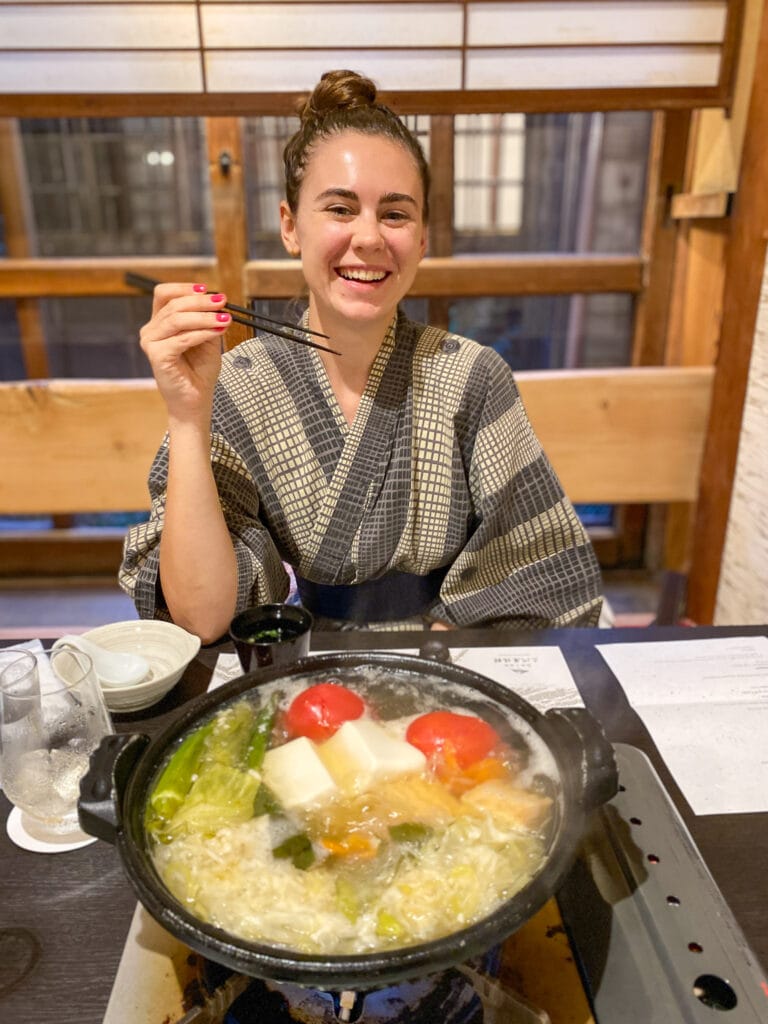
Gluten Free Tours Japan: What is It?
As I mentioned, Gluten Free Tours Japan is a small travel agency that focuses on gluten free travel in Japan.
The company is based in Australia, and run by an Australian-Japanese couple.
Meaghan is Australian, but has lived in Japan. As a vegetarian and gluten intolerant, she discovered first-hand the challenges of being gluten free in Japan. Meaghan manages client booking and communication.
Hiroshi is Japanese, and has experience as a chef. Due to his deep knowledge of Japanese restaurants and food, as well as his fluency in Japanese, he manages everything related to calling restaurants and hotels, reading labels and menus, and similar.
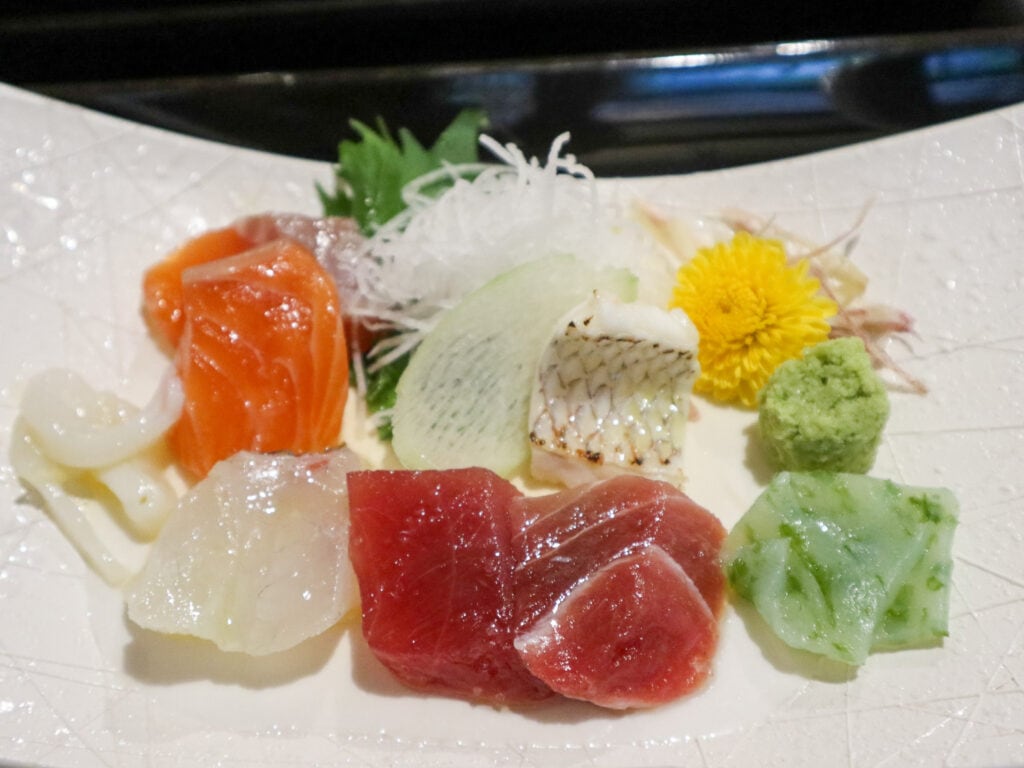
How Does Gluten Free Tours Japan Work?
If you’re anything like me, you’ve heard of Gluten Free Tours Japan before as this elusive entity that could somehow help you survive being gluten free in Japan… but you have no clue how that actually works.
Let me explain.
Gluten Free Tours Japan has two primary services: tours and culinary support.
You can book a tour of Japan through Gluten Free Tours Japan; this offering is most similar to traditional travel agents, and didn’t really appeal to me as someone who likes to have control over and book my own travels.
However, if you are looking for that extra help and you have the budget, you can book a tour.
Tours are either group tours (dates listed on their website – they offer a few per year), custom itineraries, or self-guided.
No, Meaghan and Hiroshi are not present during these tours, but the tours do include their culinary support. I will explain what that means below!
Culinary Support
Culinary support services is the core of Gluten Free Tours Japan. This is what we booked.
But what does “culinary support” actually look like? How could someone find me safe gluten free food if they weren’t actually there? I had so many questions.
Here’s a brief outline of how the culinary support package worked.
1. Book Your Own Itinerary
With a culinary support package, you have to book your own trip.
I did get Meaghan’s recommendation for a celiac-safe ryokan that they worked with, but other than that we booked our own itinerary.
2. WhatsApp Group
Then, during our actual trip, Dan and I had a group chat on WhatsApp with Meaghan and Hiroshi.
We used that chat to tell them our plan for the day, discuss restaurants, send photos of ingredient labels, make food orders, etc.
Note: This does mean you will need access to cell service while in Japan. We used a Japanese SIM card we bought at the Tokyo airport. Another option is a travel wifi device; my recommended one is SIMO Solis Lite Travel Wifi .
3. Hiroshi Phone Calls
When we arrived at a restaurant, Hiroshi (who has a Japanese phone number) called the restaurant’s landline and spoke to them in Japanese about my gluten free needs.
He would then text me which dishes were safe, and help me order my food.
4. Photo Confirmation
Before eating, I would send Hiroshi a photo of my meal and he would tell me if it looked safe or not (this saved me once when he spotted a pickle garnish that the chef hadn’t told him about, and when he called back it turned out it wasn’t gluten free!).
I share more below about how the culinary support worked during our week in Hakone, Nara, Osaka, and Kyoto.
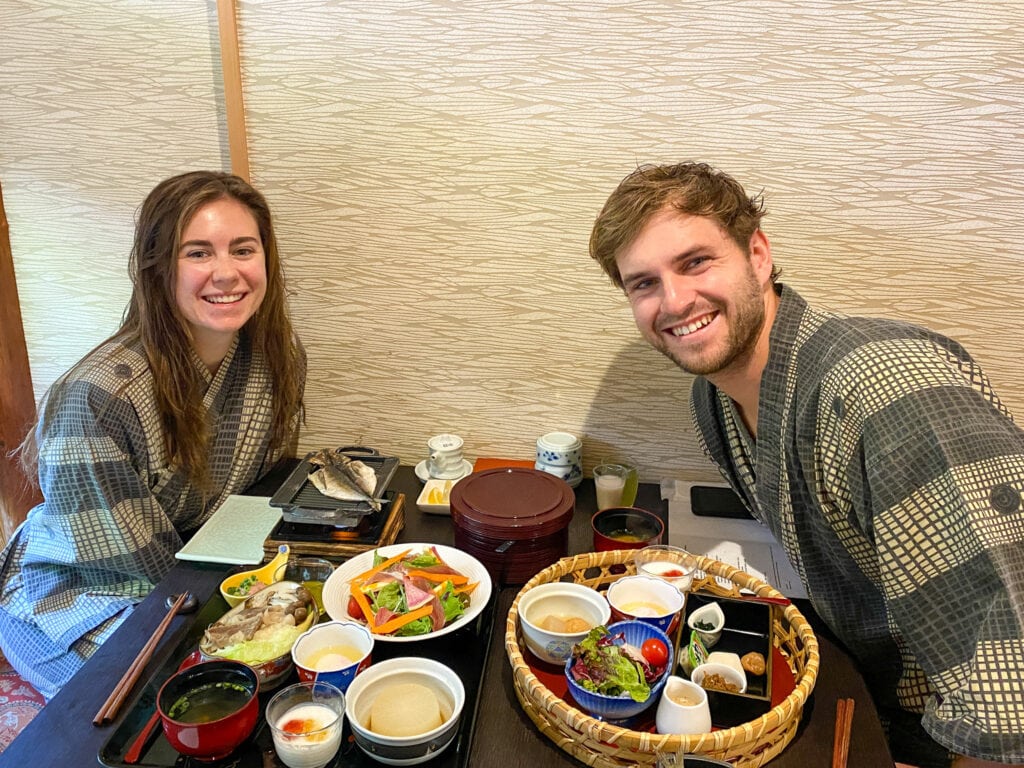
How is Gluten Free Tours Japan Different From Restaurant Lists?
But first, how is using Gluten Free Tours Japan different from using a (free) list of gluten free restaurants, like I have in my gluten free Tokyo , Kyoto , Osaka , and Hiroshima guides?
It’s actually quite different and I will explain why.
Gluten Free Restaurant Lists Are Just a Starting Point
A list of gluten free restaurants is a great starting point, but it’s just that: a starting point.
Restaurants change management, staff, and menus all the time. You have to do research on whether the restaurant still has a gluten free menu, and then when you arrive you have to deal with the language barrier.
A translation card is a great help, but it doesn’t prevent all miscommunications nor allow you to fluently ask follow-up questions.
Gluten Free Tours Japan Does the Hard Work For You
Gluten Free Tours Japan, on the other hand, provides on-the-ground support.
They do the work of finding gluten free restaurants for you (and they know about more restaurants than you can easily find on the internet).
More importantly, in my opinion, they also do the hard work of communicating with restaurant staff on your behalf – in fluent Japanese. You don’t have to stress with a translation card , Google Translate, nor the possibility that you could be misunderstood, because you have Hiroshi doing the talking on your behalf.
An additional benefit is that Hiroshi and Meaghan can contact the restaurant by phone ahead of time and let you know if it’s even worth going there or not, saving you time you might have lost getting turned away from a restaurant that no longer serves gluten free food.
TL;DR: They Are Both Valuable
Look, I’m a gluten free travel blogger so I am never going to tell you that gluten free restaurant lists are useless.
I believe they’re an incredible resource for planning your trip and getting inspired about the gluten free food possibilities. But I also believe they have their limitations. They’re only useful if you’re willing to put in extra work.
Gluten Free Tours Japan goes beyond those limitations in a way that a list on the internet could never.
Each has their own place. They don’t serve the same purpose and are not mutually exclusive.
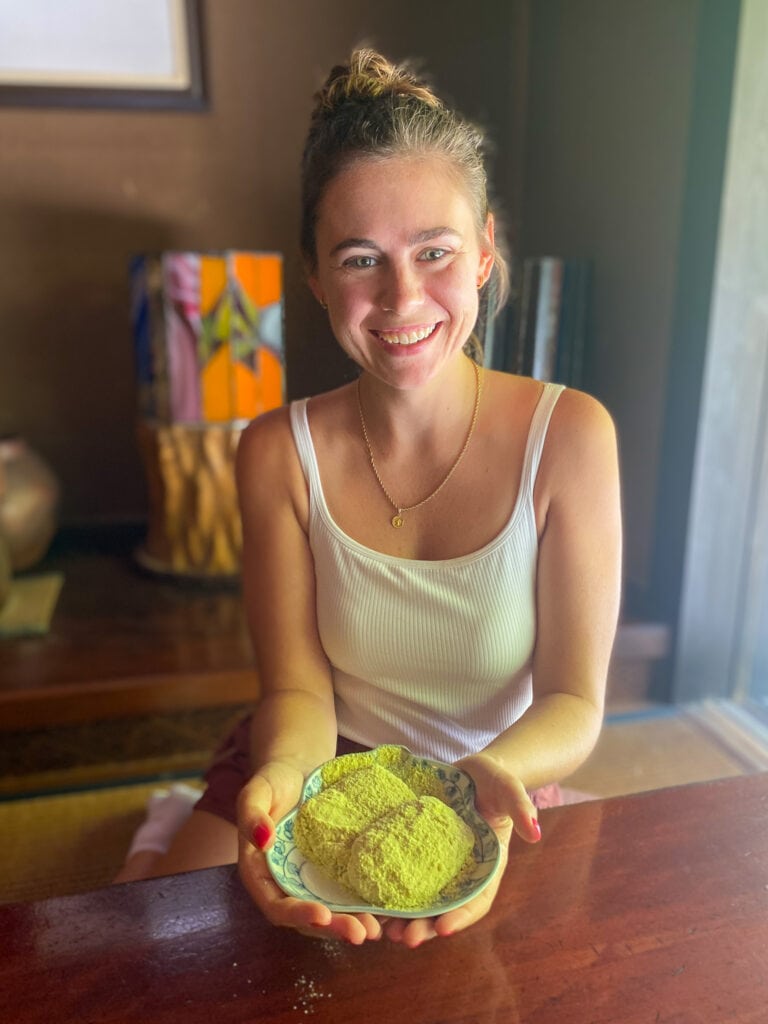
Cost And How to Book
Updated prices for Gluten Free Tours Japan’s services are listed on their website.
When we visited, the cost of a week of culinary support was $990 AUD , which is about $660 USD. I paid via Wise international transfer (low fee, I’ve used them for years! You can use my link for a fee-free transfer).
That is about $94 USD per day, for Meaghan and Hiroshi’s help finding and ordering gluten free food. I will tell you further down this article if I think that was worth it!
Organized or self-guided tours are much more expensive, naturally, because they include accommodation and transport. Prices are listed on their website.
Email them at [email protected] to book, and tell them Sarah from Endless Distances referred you!
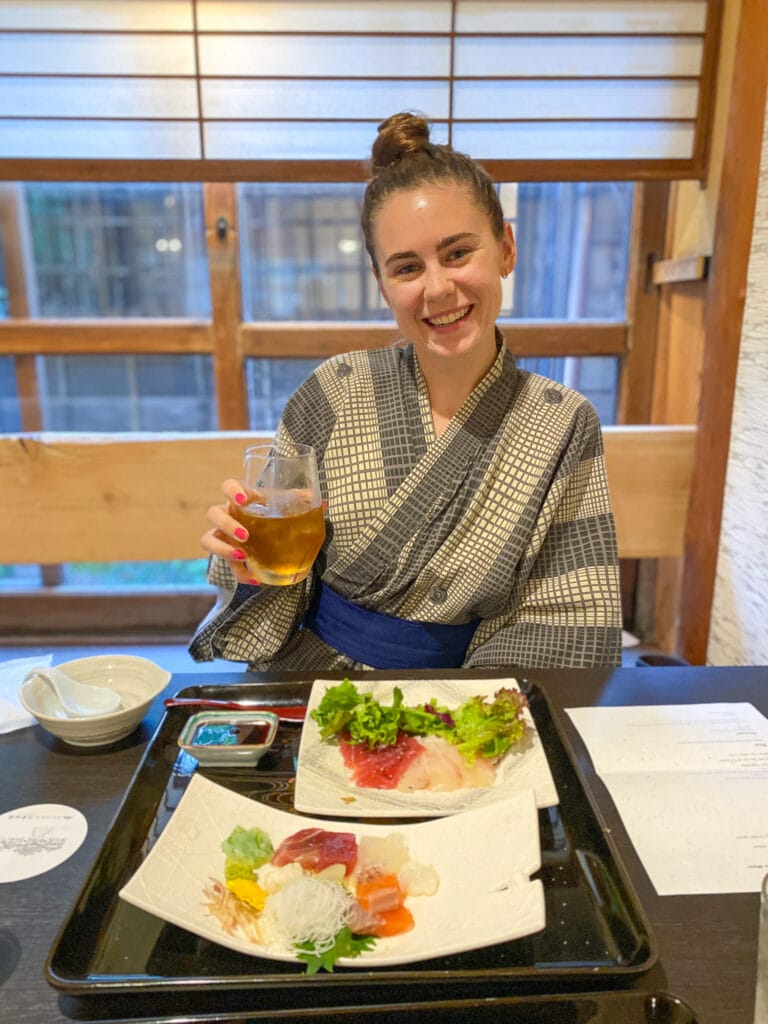
Our Experience With Gluten Free Tours Japan: Honest Review
We booked them for only one week out of our month in Japan, but I made a strategic choice to use their services when we were in more remote areas (namely, Hakone and Nara) where I’d need more help. This is how our week with them went down!
Days 1-3: Hakone
We spent our first couple days using Gluten Free Tours Japan’s services in Hakone.
On our first day, Hiroshi helped me find some gluten free snacks at a 7-11 for our train journey.
Then he and Meaghan pulled a feat of finding me a celiac safe sashimi bowl ( with gluten free soy sauce! ). We were doing the Hakone Loop and in a pretty remote location, but somehow they found this place right at lunch time. It was perfect, simple, delicious, and one of my most memorable meals.
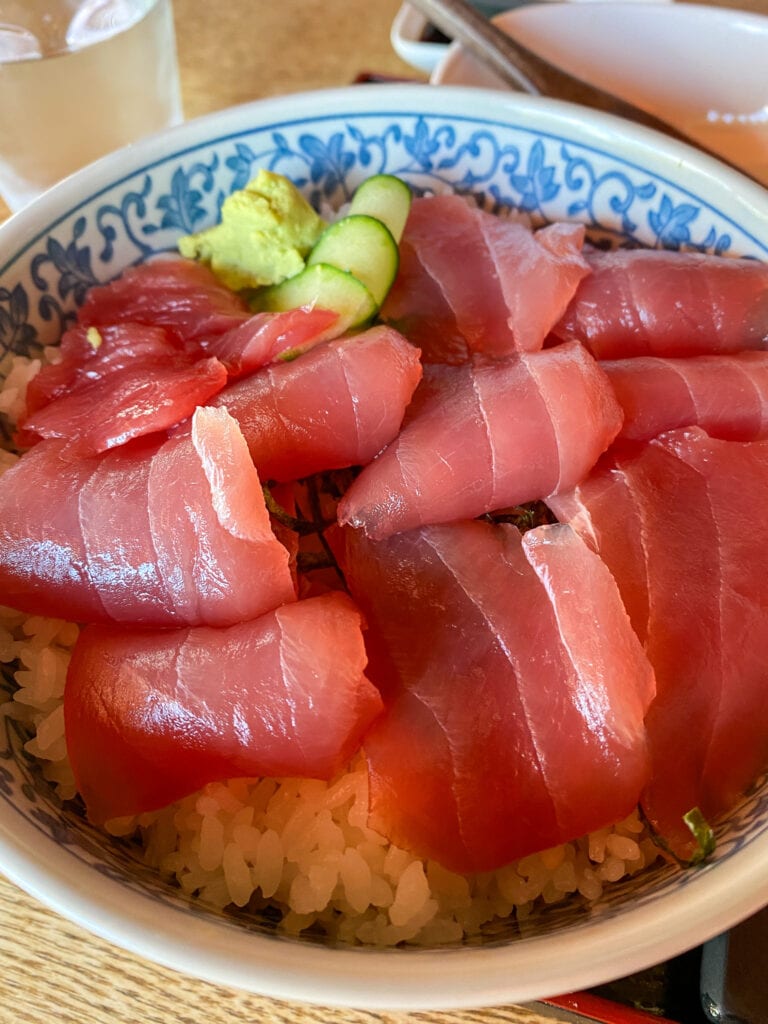
Of course, they also helped us book an incredible ryokan with a private onsen.
The ryokan stay included an elaborate shabu shabu (hot pot) dinner. In order for my meal to be gluten free, there were SO many modifications. I honestly never could have managed this on my own and I was really grateful to have their help.
Hiroshi also saved me when they refilled our hot pot with broth… I got a nervous feeling so I asked him to call and double check for me that the new broth was still gluten free. It turns out it WAS NOT GLUTEN FREE!
Thank goodness for my gluten spidey senses and thank goodness for Hiroshi talking to them! We promptly got a new pot, utensils, and gluten free broth and everything was okay.

The next morning, we had an elaborate breakfast at our ryokan. Such a fun experience!
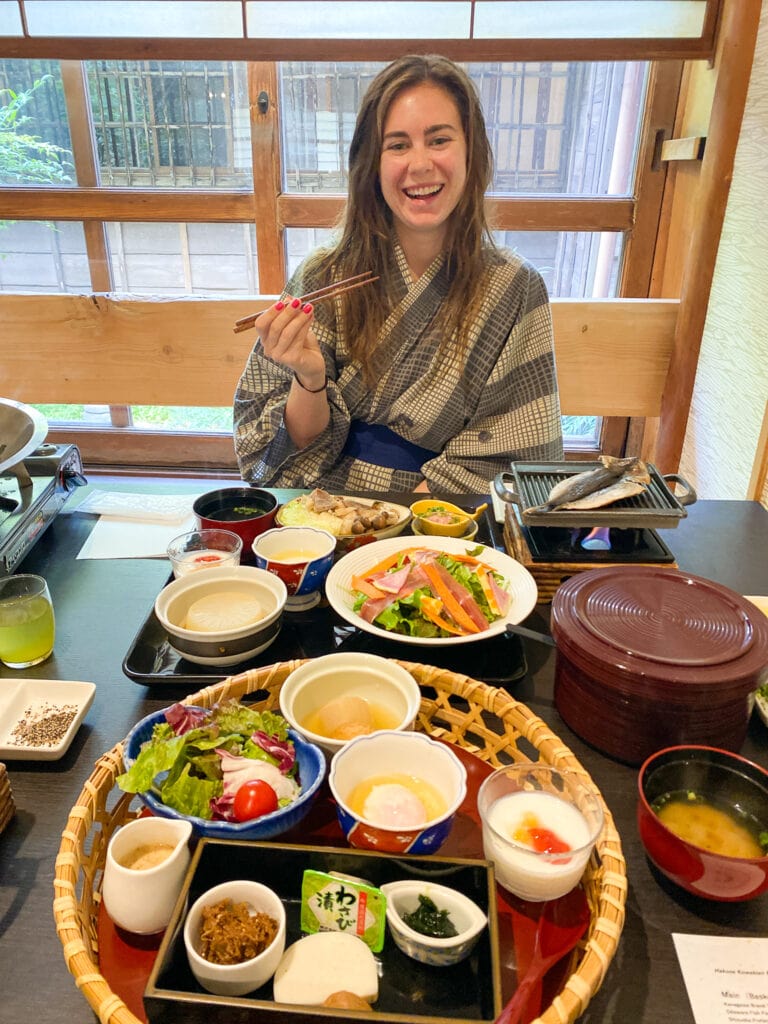
Meaghan and Hiroshi also helped me order gluten free mochi at an ancient tea house in Hakone that I really wanted to visit (this is where Hiroshi saved me from the gluten-y pickles!), as well as find a wonderful yakiniku restaurant for dinner on our second night.
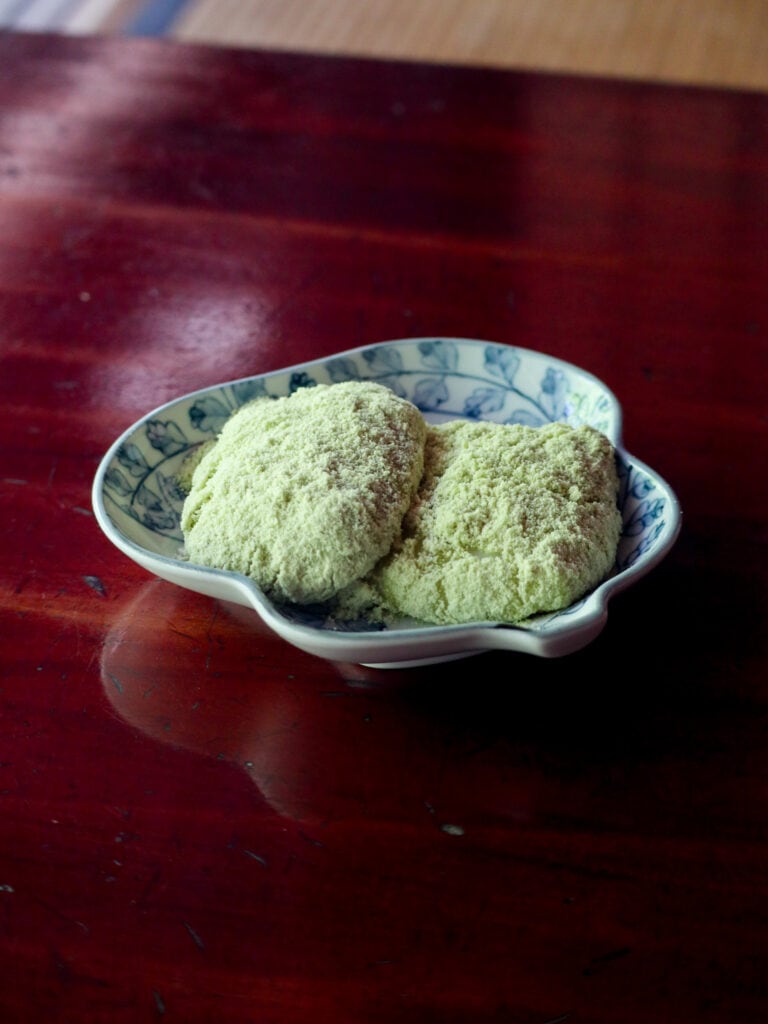
Days 3-4: Osaka
After Hakone, we headed to Osaka for one night. Osaka is a big city and I’d done a lot of research on gluten free restaurants in Osaka . Dan and I were coming back to Osaka at the end of our trip, so in order to maximize our time with Gluten Free Tours Japan I set them the annoying challenge of finding me some under-the-radar restaurants.
Well, they definitely hit it out of the park with a 100% gluten free cafe that served celiac-safe omurice and cheesecake. Complete with the NICEST owner and cutest dog!
You won’t find this cafe listed on any blog posts or apps… it’s a true secret and both Dan and I just loved it.
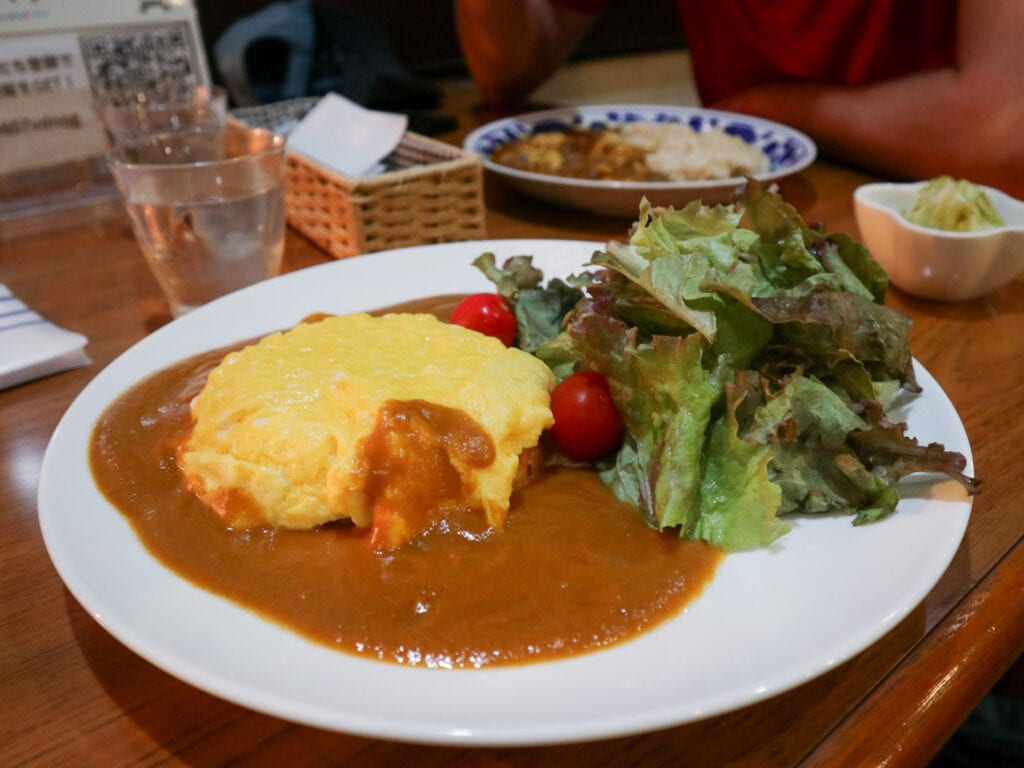
They also helped us explore Kuromon Ichiba Market, which is the big food market in Osaka. Hiroshi called me on WhatsApp and then I passed my phone over to the food stall owners.
It was sooo funny seeing their reaction to having someone on my phone speak fluent Japanese to them, haha. And it worked really well – I had some delicious food!
RELATED | Gluten Free Tsukiji Fish Market in Toyko Guide
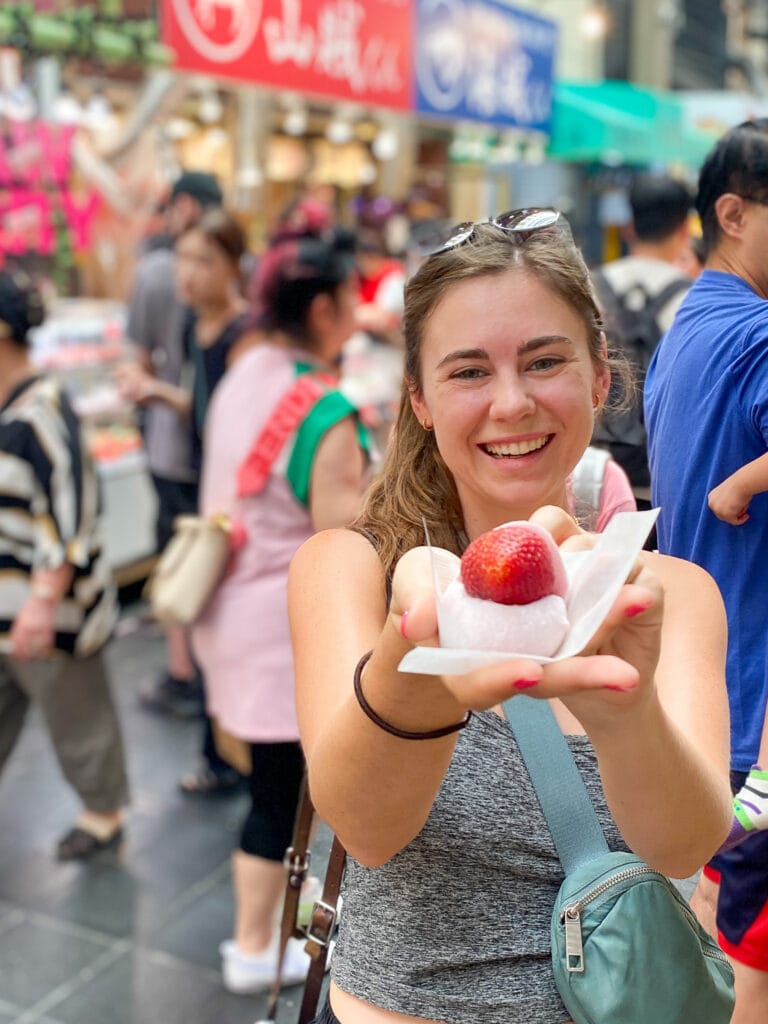
For dinner, we had some high hopes but unfortunately Dan got an upset stomach, so at the last minute we had to change plans. Meaghan and Hiroshi just rolled with it despite them already having put in time researching our original dinner plans.
They helped me get takeout tacos, and took all the stress out of it by calling ahead for me.
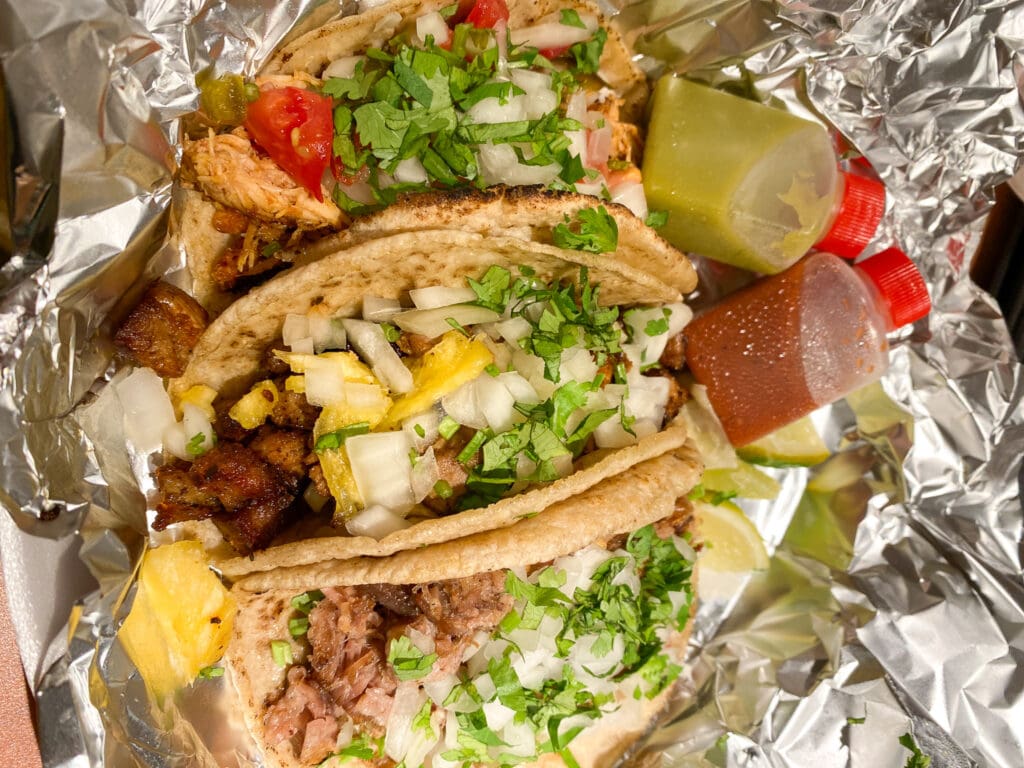
Days 4-6: Nara
After Osaka, we spent two night in Nara. Honestly, Nara was the biggest struggle of anywhere we went in Japan, even with the help of Gluten Free Tours Japan.
Saying that, it would have been way more difficult without them and in hindsight I wish we’d just stayed here one night. (Although our hotel was awesome – Onyado Nono Hot Springs Hotel for anyone curious!).
My highlights in Nara were Meaghan and Hiroshi helping me get safe mochi from the traditional mochi pounder, a safe afternoon snack of tea and warabi mochi at a quaint tea house, and also helping us navigate which sakes were gluten free at a special sake-tasting. (When I list those all out, Nara doesn’t seem so bad, does it?).
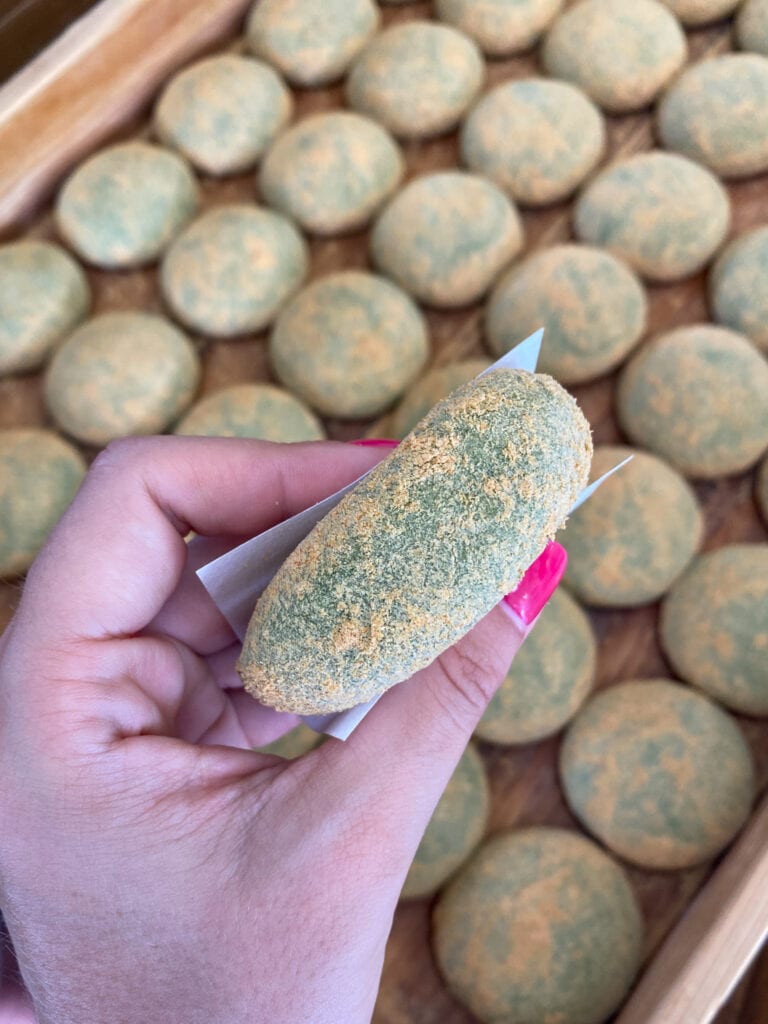
Dinner was more of a struggle, and both nights we unfortunately had our plans fall through thanks to restaurants changing their gluten free status, unexpectedly closing, or not being safe.
I think it’s important to remember that Gluten Free Tours Japan is incredibly helpful, but they are not miracle workers so you shouldn’t have unrealistic expectations of them. The truth is that travel with celiac disease is tough and not every day is going to be amazing!
Saying that, on our first night they did manage to find us celiac safe gluten free pasta at the last minute, and they even called the restaurant who stayed open late for us!
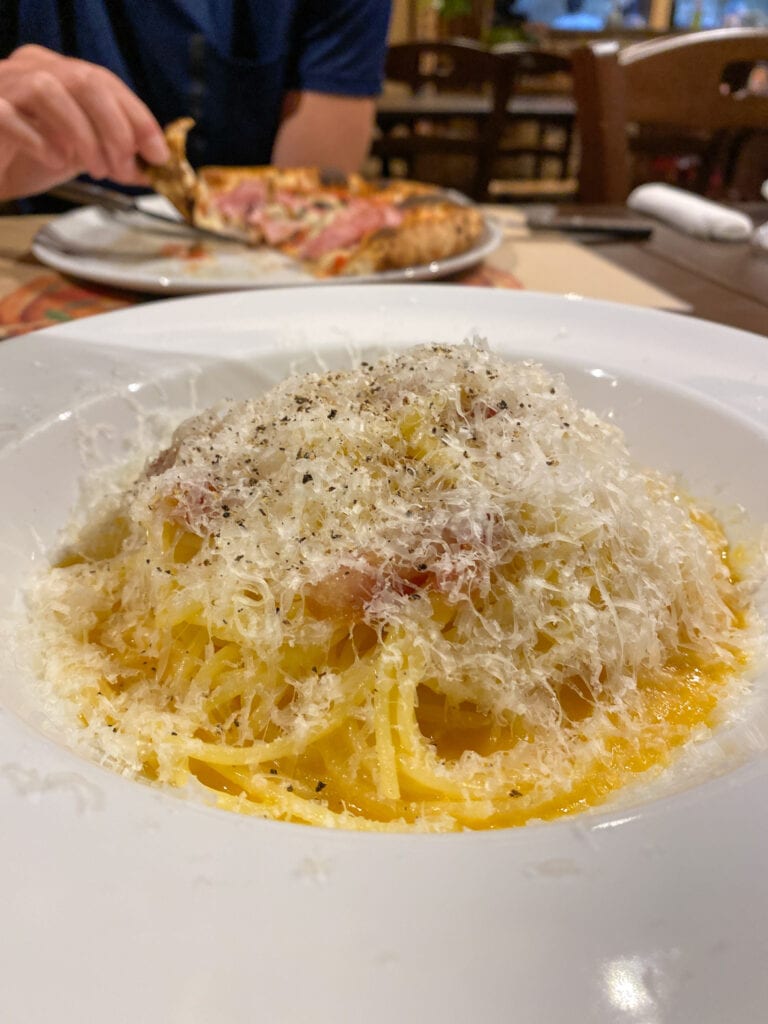
Days 6-9: Kyoto
You are probably wondering why this says “days 6-9” when we’d only booked one week with Gluten Free Tours Japan. Well, Meaghan and Hiroshi felt bad about how things went down in Nara and they offered us two extra days free of charge.
Honestly, we did not expect that whatsoever (sometimes it’s just hard to be celiac and that wasn’t their fault) and it was really, really kind of them.
We had not originally planned to use their services in Kyoto because, being a larger city, there are more gluten free restaurants there. We tried not to take advantage of their generosity in Kyoto and had already reserved some meals ourselves.
However, I definitely took them up on their help for a wonderful lunch in Arashiyama where we had a full set menu including gluten free tempura!! I’d actually found this restaurant in my own research, but had no clue if the tempura was celiac safe nor how to make a reservation. I’d figured we just wouldn’t be able to eat there and I was sad!
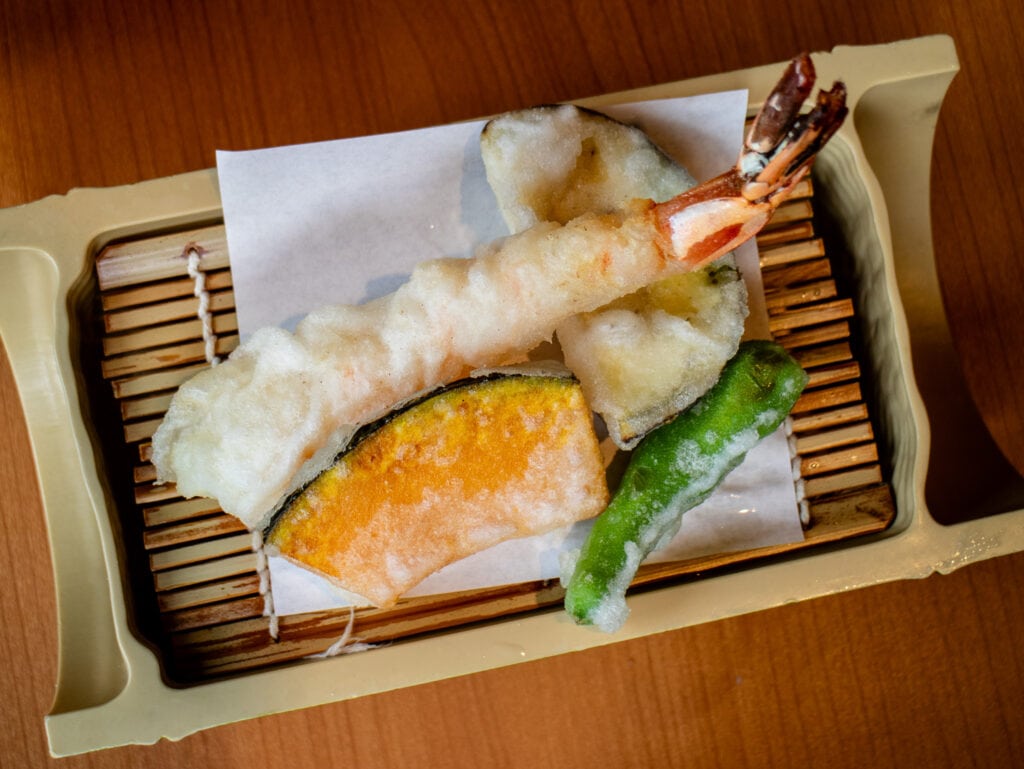
Thanks to having Meaghan and Hiroshi’s help, though, they were able to make us a reservation and confirm that the tempura was okay for me to eat! It ended up being an incredibly delicious meal.
This is a good example of how a list of gluten free restaurants is just a starting point, and not a replacement for their services.
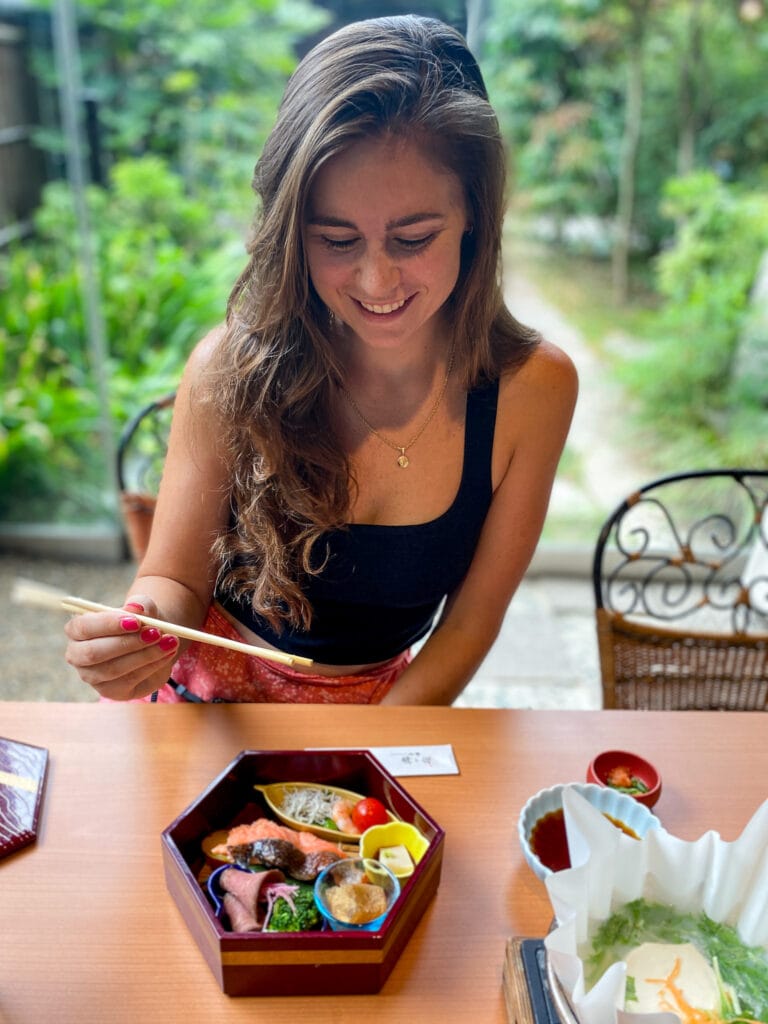
While in Kyoto, Meaghan and Hiroshi also found us gluten free Japanese curry, and gluten free sushi.
Both of those restaurants don’t show up in any searches of gluten free restaurants in Kyoto, and are true hidden gems.
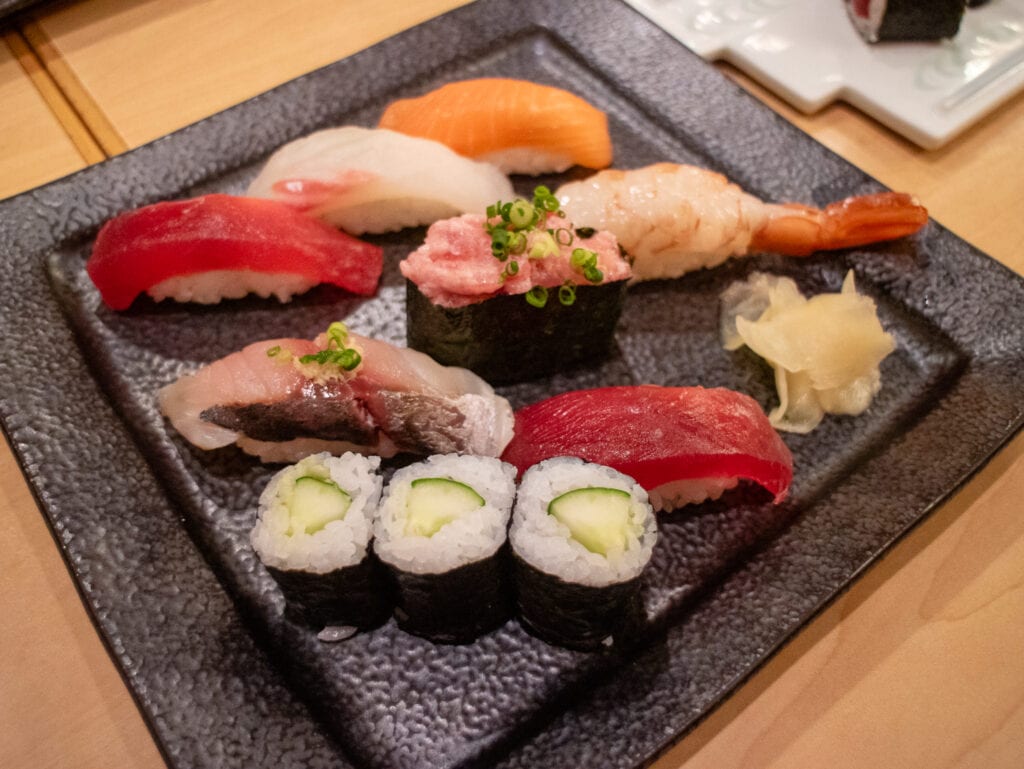
Benefits of Using Gluten Free Tours Japan
Now, let’s talk about my thoughts on Gluten Free Tours Japan and whether it’s worth it.
Let me start out by saying that I have had celiac disease for 13 years. That means for 13 years I have been in charge of finding safe GF food, by myself. Sure, Dan is a great support to me, but ultimately it is my burden to bear and my responsibility.
My week with Gluten Free Tours Japan was the first time in 13 years that I was not the #1 person communicating to restaurants about my gluten free needs. It was, honestly, kind of an emotional experience. I think that I didn’t even realize the extent of the burden of being gluten free, until it was lifted for me.
Sure, I was still being careful and keeping an eagle eye out for possible gluten, and occasionally researching restaurants, because that’s life as a celiac, but 90% of the burden was gone.
That is the #1 benefit of Gluten Free Tours Japan, in my opinion. Every celiac deserves to experience that. Below are more benefits to using Gluten Free Tours Japan.
Take a True Vacation
If you’ve read my gluten free Japan guide , then you know that it’s hard work to be gluten free in Japan. It’s definitely possible, but there is a lot to learn and keep track of.
It is understandable, then, that you may not want to “work hard” during what is supposed to be a vacation! With Gluten Free Tours Japan, you can actually feel like you’re taking a vacation.
Yes, I was on vacation in Japan, but for the first time in 13 years it felt like I also got a vacation from being celiac!
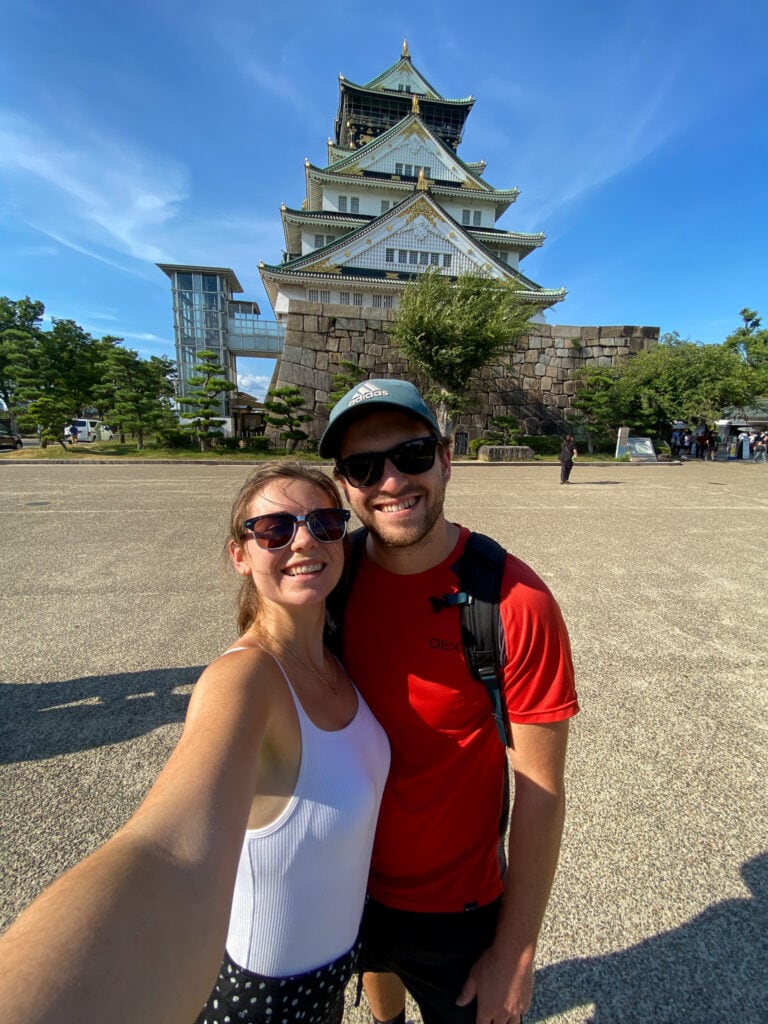
Meaghan and Hiroshi save you a ton of time researching restaurants.
I noticed that they tried hard to find us restaurants that were conveniently located to where we planned to be around mealtimes.
Communication with Restaurants
Of course, one of the biggest benefits is that Hiroshi speaks fluent Japanese and has a Japanese phone number. He spoke to all restaurants on my behalf, fluently explaining celiac disease, cross contact, and my gluten free needs.
Beyond the benefit of being confident I was getting safe gluten free food, it was also funny to see the reactions of the food service workers.
Suddenly, they’d become way more interested in us and ask about our “Japanese friend” haha.
Reservations
Hiroshi is able to make restaurant reservations on your behalf, which is very useful because quite a few Japanese restaurants only take reservations on the phone and only speak Japanese.
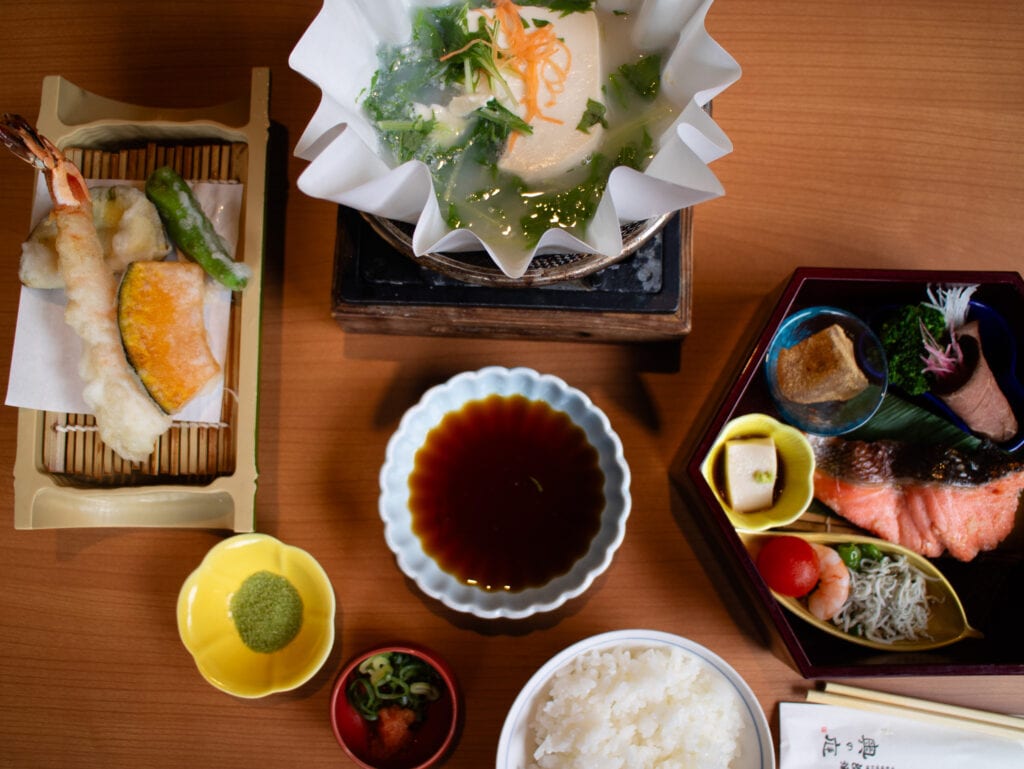
Under-the-Radar Restaurants
Meaghan and Hiroshi know about a number of under-the-radar gluten free restaurants (or restaurants that can accommodate celiacs) that you won’t find listed on travel blogs or in Facebook groups.
This opens up more authentic-feeling restaurants, rather than those that only cater to Western tourists.
One of my favorite meals with Hiroshi and Meaghan’s help was a small restaurant in Hakone that served us a gluten free sashimi bowl. Eating here was effortless with their help. And without them, I can guarantee I wouldn’t have eaten lunch that day!
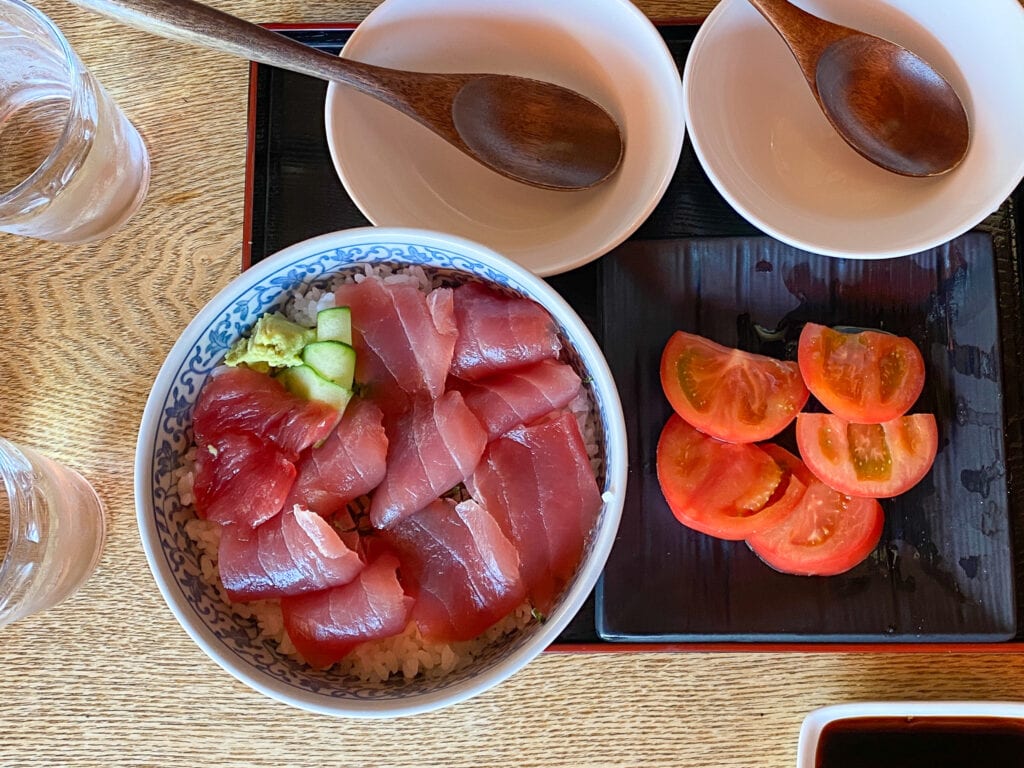
Finally, an underrated benefit of Gluten Free Tours Japan is the interaction with Meaghan and Hiroshi!
They are always there on WhatsApp. Dan and I would talk about them so much (“send this photo to Hiroshi” “Meaghan just said this” “There goes the phone ringing… it must be Hiroshi” “Hiroshi says it’s safe!!”) that it almost felt like they were there with us.
It was really special to travel Japan and feel like I had a back up squad who totally understood the ups and downs of being gluten free, without me having to explain that. I am so grateful that I got to “meet” them!
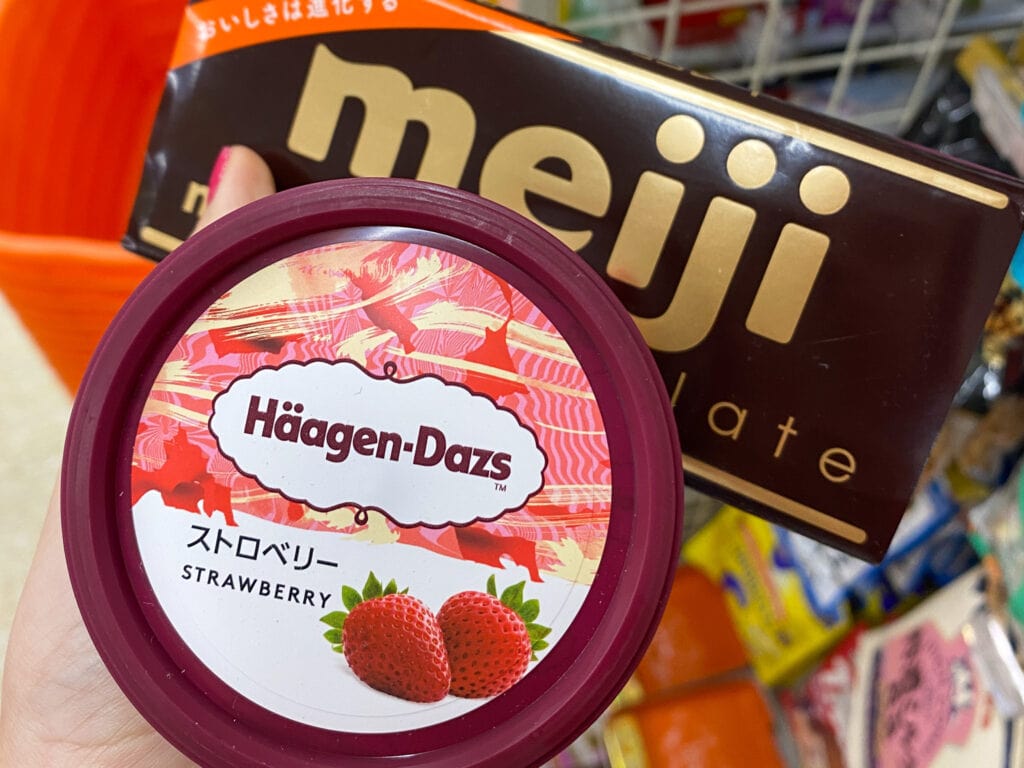
Drawbacks of Using Gluten Free Tours Japan
Because this is an honest review, here are some drawbacks to consider when you’re booking Gluten Free Tours Japan.
The most obvious drawback to using Gluten Free Tours Japan’s services versus not using them, is that it costs money!
Whether you actually consider this a drawback or not is personal and based on your own budget.
In my opinion, the value of their services changes based on where you are and how difficult it is to find safe gluten free food. It’s useful to take this into consideration if you’re only booking their services for part of your Japan itinerary, like we did.
As a sensitive celiac on a mid-range budget in Japan, I definitely thought their services were worth the cost for the locations we were in.
Availability
This isn’t technically a drawback of using their services, but rather a consideration. Gluten Free Tours Japan is a very small company and can sell out during busy times of year.
Contact them as far in advance as possible to ensure they have availability, so you aren’t disappointed!
Organization
Again, this isn’t really a drawback but more an area for improvement.
I think that before the services started, it would have been nice to get some kind of introductory document with information on being gluten free in Japan , how their services worked and what to expect, and a list of likely-GF conbini food (to save time sending photos). None of that is mandatory of course but it would have been a nice touch.
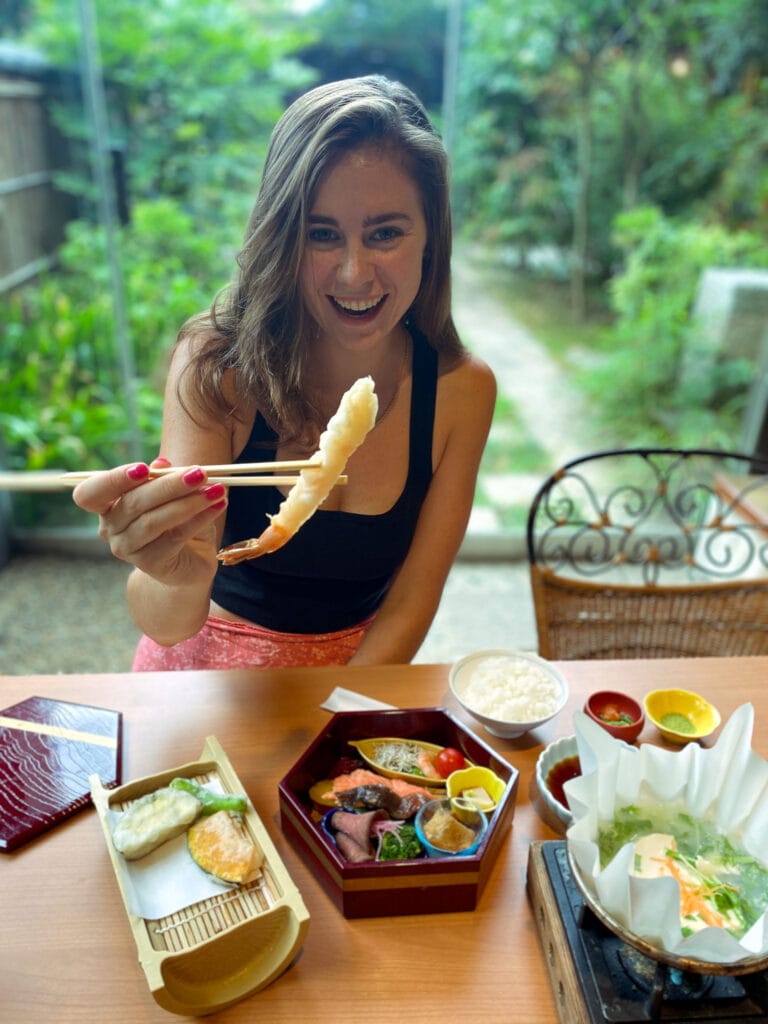
Who I Recommend Gluten Free Tours Japan Services For
Now that you’ve read my Gluten Free Tours Japan review, let’s talk about who their services are best suited for, in my opinion.
There are some people who will, without a doubt, benefit from Gluten Free Tours Japan, and perhaps shouldn’t even consider visiting Japan without them:
- Newly diagnosed celiacs (<5 years)
- People who haven’t done much international travel with celiac
- Families with gluten free children
- Mixed groups where one or more people are gluten free and others eat gluten
- People who want the most stress free trip possible, and have the budget
I also think you need to consider your actual itinerary. Even the most experienced celiacs, like myself, can still really benefit from Gluten Free Tours Japan’s help depending on where you’re visiting.
Japan itineraries that will benefit from Gluten Free Tours Japan’s help include:
- Fast-paced itineraries (ie, not much time to search for food on your own)
- Travel outside major cities (Tokyo, Kyoto, Osaka)
- Any days spent in remote or countryside areas
- Accommodation involving food, like a ryokan or temple stay
- Hiking or pilgrimages
- Foodie-focused itineraries
Would I Use Gluten Free Tours Japan Again?
The short answer is yes , I would book Gluten Free Tours Japan’s services again.
However, personally, on a return visit I would only book them for travel in Japan outside the major cities.
I found it relatively easy to navigate Tokyo , Kyoto , and Osaka and I don’t feel that I would require their services there again.
Saying that, I have had celiac disease for 13 years , and during that time I’ve visited 50+ countries . I am a full-time gluten free travel blogger ! My point is that I have a LOT of experience with gluten free travel, so my opinion cannot be generalized to the majority of gluten free travelers.
PLEASE don’t take this as me saying YOU shouldn’t book their services in Tokyo, Kyoto, or Osaka. This is purely my personal opinion for my own unique circumstances.
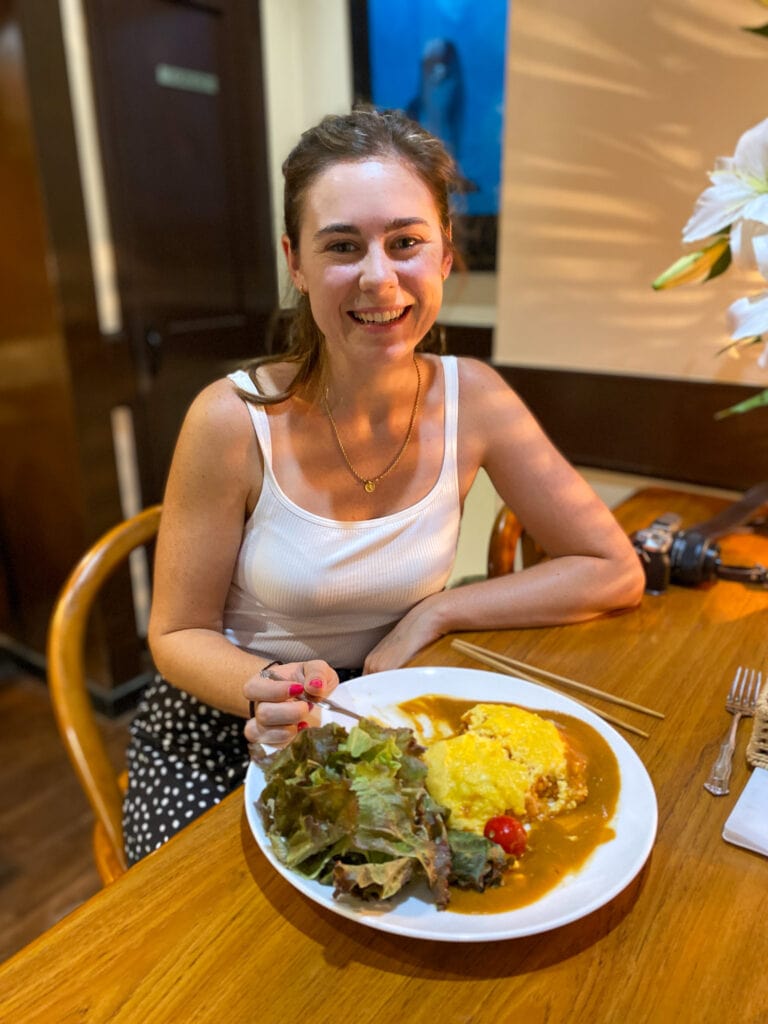
Final Thoughts
It’s only been a couple months since I was in Japan, but I seriously dream of returning to Japan and exploring more of the countryside and remote areas.
There is a 100% chance that I will book Gluten Free Tours Japan’s services when the time comes for that! Honestly, it is hard for me to even imagine visiting remote areas of Japan without their help.
I hope that this honest review of Gluten Free Tours Japan has answered some of your questions, and given you insight into what a day using their services actually looks like.
If you have questions about my experience, leave me a comment below.
If you’d like to book their services, shoot them an email at [email protected] and tell them Sarah from Endless Distances referred you!
Check out my other gluten free Japan posts…
Ultimate Gluten Free Japan Guide
Gluten Free Snacks in Japan: 7-11, Conbinis, and More
Tokyo Gluten Free Guide
Osaka Gluten Free Guide
Kyoto Gluten Free Guide
Hiroshima Gluten Free Guide
100% Gluten Free Cooking Class in Osaka: Complete Review
Gluten Free Sushi Making Class in Tokyo: Complete Review
Tsukiji Fish Market in Tokyo: Gluten Free Mini Guide

Pin it for later…

Looking for more?
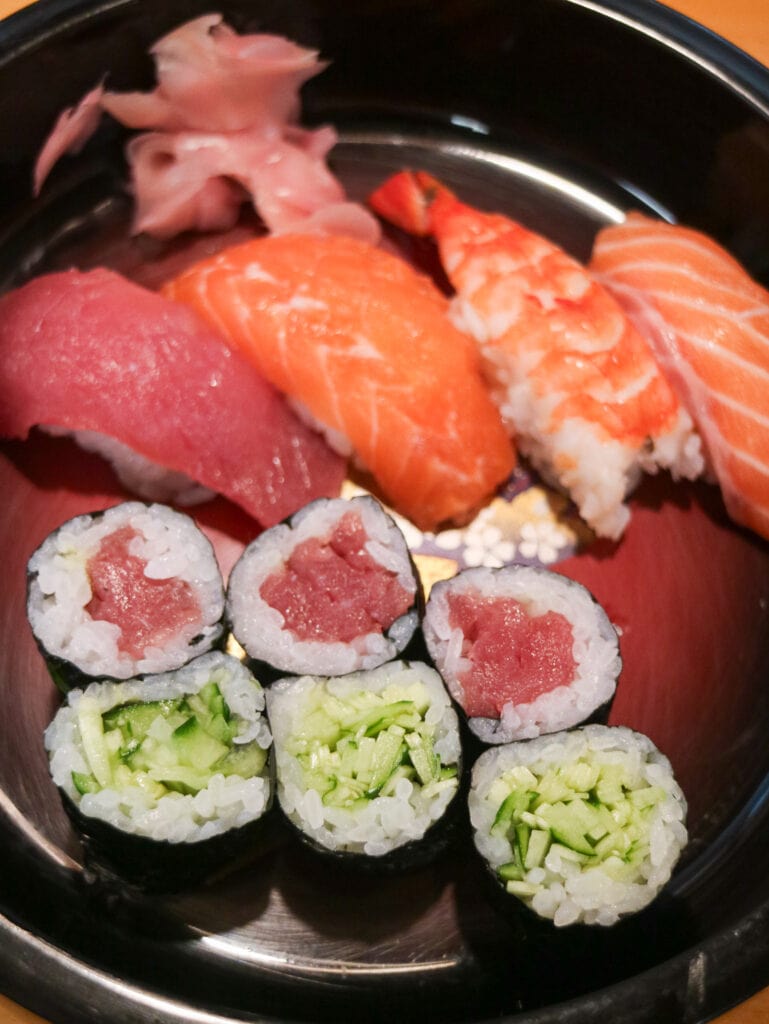
The Ultimate Gluten Free Japan Guide (2024)
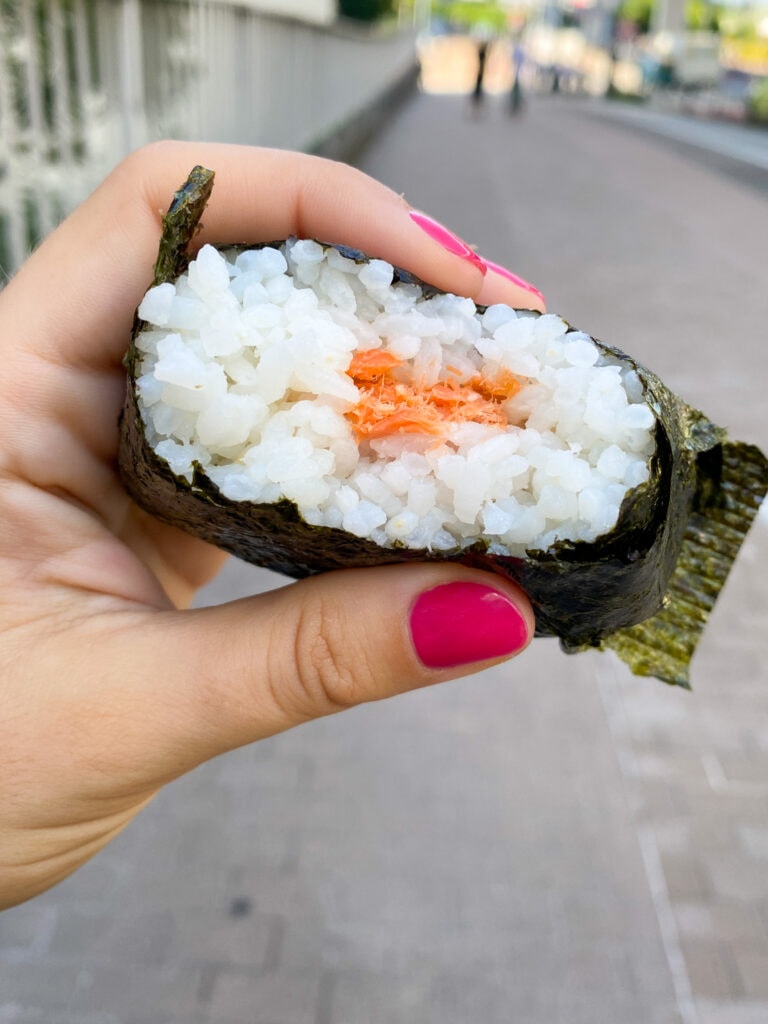
A Guide to Gluten Free Japanese Snacks: 7-11, Conbinis, and More
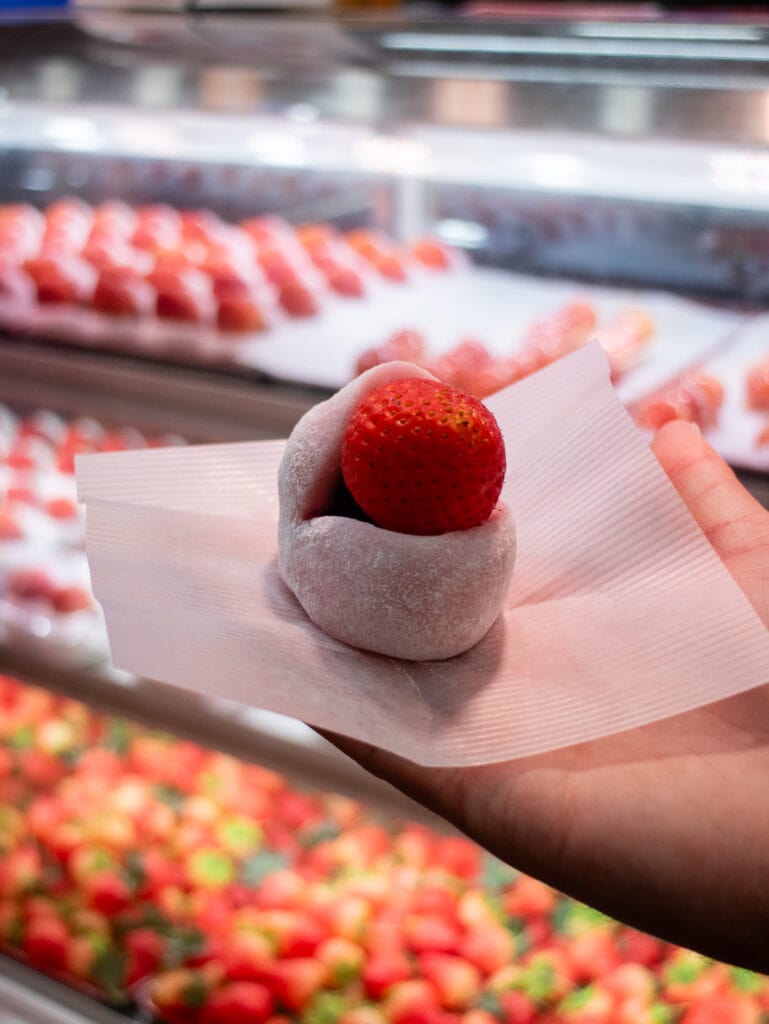
Gluten Free Osaka: The Complete Travel Guide (2024)
Leave a reply cancel reply.
Your email address will not be published. Required fields are marked *
Gluten Free Tours Japan

- See all photos

Similar Experiences

Most Recent: Reviews ordered by most recent publish date in descending order.
Detailed Reviews: Reviews ordered by recency and descriptiveness of user-identified themes such as waiting time, length of visit, general tips, and location information.
Gluten Free Tours Japan - All You Need to Know BEFORE You Go - Visiting Tips (2024)
Gluten-free Food Tours ( 48 )
Copyright © 2024 Celiac Travel.com
How to Travel Gluten Free in Japan
- Last Updated: February 21, 2019
Japan is one of the hardest countries to be gluten free that I have ever traveled to. Almost everything is served with soy sauce or breading, communicating or reading food labels is nearly impossible, and as Japan has one of the lowest instances of Celiac Disease, there is little cultural understanding about what it means to be ‘gluten free’. but with some preparation, it’s possible to travel safely and still enjoy Japanese cuisine. It’s a beautiful and fascinating country, so don’t let the food challenges turn you off visiting. I spent two weeks travelling through both major tourist hubs and off the beaten path spots, was ‘
With some preparation though, it’s possible to travel safely and still enjoy a little bit of Japanese cuisine along the way. It’s a beautiful and fascinating country, rich with history, that is safe and rewarding to explore so don’t let your food challenges turn you off visiting. I spent two weeks travelling through both major tourist hubs and off the beaten path spots. I was ‘glutened’ twice, and was surprised it wasn’t more. I have been to 28 other countries and the only other place as hard to travel gluten free, was China. It was worth it though, but planning is critical.
Here are some tips for a safe and healthy gluten free trip:
Preplanning
I highly recommend careful pre-planning before you arrive in Japan. Plan to shop for supplies several days in advance to help ensure you have everything you need, as it’s very hard to find gluten-free products or familiar Western food brands in Japan. Below are some suggestions of food items to bring with you, and tips to get ahead of the difficult language barrier.
Bring your own soy sauce
I can’t emphasize this enough. Unless you are ok with having your sushi and sashimi with lemon and salt, bring your own soy sauce. Bring it out with you everywhere you go. Every meal will be seasoned with it. Having your own sauce will make your meals more enjoyable, provide you more options and give you more ability to fit in for group meals. If you can bring one-off individual packs, that might be easier than bringing a whole bottle, but I went through a lot and it was easy to pack a bottle in my suitcase.
Bring your bars/snacks
There were many meals where I couldn’t join in, and could only have plain rice and raw fish. There were other times where I couldn’t find a restaurant that would serve me for hours. Having a supply of GF granola and Lara bars really helped. I went to Costco before my trip and bought two boxes of Peanut Butter Chocolate Lara bars. I ate like 16 of them in two weeks (and will never eat one again!). Plan at least one GF snack per day of your trip.
Bring language cards
I always recommend bringing language cards for travel to any foreign destination, but the language and cultural barrier are even harder in Japan, so absolutely bring language cards. I found the most successful ones were the lengthier ones, that present the info as “what I can’t eat” items as well as ” what I can eat” items. These significantly increased my options over very basic ones which only detailed what foods to avoid. With the simpler cards, several restaurants just told me ‘no’. Even consider bringing a few different cards to try.
Learn the kanji
This is difficult for non-Japanese speakers, but learning (or printing a card with) even the 3 main ‘kanji’ symbols that represent wheat, barley and gluten will help when reading the packaging on food and snacks. Luckily Japanese packages clearly list ingredients, so even if you have to show the package and a card to a local, they will usually understand how to help you read it. Even better is to get a wifi plan and use google translate to read labels looking for obvious gluten.
Make sure these kanji don’t exist on food packages:
小麦 (shinjitai kanji, kyūjitai kanji 小麥, hiragana こむぎ, romaji komugi)
Finding Food in Japan
7-11 and Family Mart convenience stores are everywhere in Japan and have several good GF options. I regularly found hard-boiled eggs, edamame beans, fruit and plain rice ‘onigiri’ triangles. There is also onigiri with meat and red bean inside, which may be gluten free, but you need to check the label. These items combined were a daily meal for me, and great for long distance travel as most train stations have convenience stores.
Eating these items from convenience stores was often a better option for me than trying to eat in restaurants, and much cheaper too. Many major cities have familiar chain restaurants, and items like fries at McDonald’s are rumoured to be gluten free but I can’t confirm that.
Although I found no speciality stores selling gluten free products, there is a chain of international food stores called Kaldi, which can be found at most major train stations. They sometimes have recognizable brands from home or other ethnic foods which might be useful in cooking meals for yourself. For example, they had tortilla chips, Thai curry sauces and also Vietnamese rice noodles. The large chain store Don Quixotes may have familiar brand snack foods or items like fruit chips.
I highly recommend staying in an apartment or guesthouse with a kitchen when possible. Cooking your own meals is both safer and cheaper when travelling in Japan. Grocery and food stores will have meats, dairy, rice and produce. Spices and sauces that will be hard, so if you plan to self-cater a lot, it wouldn’t hurt to bring some flavouring items.
Restaurants
The main gluten free options in Japanese restaurants include; sushi and sashimi. If you don’t bring soy sauce, ask for lemon and salt to flavour. Don’s assume sushi is always GF though, sushi rice sometimes contains vinegar made with wheat or barley. Also, make sure they don’t use soy sauce to pre-marinade fish.
Other options that might be gluten free include; yakitori meat skewers (ask for it prepared with salt and no soy sauce) and shabu-shabu, which is meat and vegetables that you cook for yourself in a hotpot. On the rare occasion, you can also find soba noodles made with 100% buckwheat, but be mindful that the ‘hot’ or ‘with soup’ noodles likely have soy sauce added to the water, so ask for cold, plain noodles and use salt to flavour or ask for hot water and use your own soy sauce to flavour.
Lastly, don’t feel limited to only Japanese restaurants, I had one of the most incredible Mexican meals of my life at a restaurant in Shinjuku (the red light area in Tokyo) and some great Thai and Indian meals in other Japanese cities as well. They often speak English in popular tourist restaurants but it is safer to bring language cards in a variety of languages if eating out a lot. A server who isn’t Japanese may not be able to read the Japanese language, so having a few popular language cards can help.
Of the 30 or so countries I have travelled to, Japan (and secondarily China) was the hardest country to travel gluten free. I had a few incidents, despite careful pre-planning, self-catering, and very simple meals. It can difficult to explain your needs within the cultural and language barriers, but the people graciously want to help you. There is just a lot of wheat and soy sauce in everything. That aside it’s an incredible country that I am so glad I visited.


Share this post
Follow me on instagram.

About Cant Stop Dreaming
If you are a busy traveller looking travel tips and itineraries, you’ve come to the right place! This blog focuses on budget travel around Canada and Internationally, with a focus on weekend getaways, outdoor adventures, and photography.
Keep Connected
Copyright © 2011-2021 · cantstopdreaming.com · all rights reserved.
Gluten Free Tours Japan

- See all photos

Similar Experiences

Most Recent: Reviews ordered by most recent publish date in descending order.
Detailed Reviews: Reviews ordered by recency and descriptiveness of user-identified themes such as waiting time, length of visit, general tips, and location information.
Gluten Free Tours Japan - All You Need to Know BEFORE You Go (2024)

Vegan and Gluten Free Walking Tour in Tokyo
- Tour Reviews
Set out on a culinary adventure through the bustling streets of Tokyo, where dietary restrictions are no obstacle.
Discover the Vegan and Gluten Free Walking Tour, a meticulously curated experience that caters to the needs of vegans and those with gluten sensitivities. This unique tour, brought to you by Viator, unveils the hidden gems of Tokyo’s vibrant food scene, showcasing a variety of delicious and authentic Japanese dishes that adhere to your dietary requirements.
From traditional cuisine to street food and sweet treats, this tour promises to satisfy your taste buds while immersing you in the cultural significance of each dish.
Get ready to explore Tokyo’s culinary delights like never before.
Great News! You can reserve your spot for free with Viator. You can easliy cancel any time up to 1 day before without paying anything.
Quick Takeaways
- Tokyo offers a vibrant and diverse vegan and gluten-free food scene, with numerous restaurants and cafes providing delicious options.
- Traditional Japanese cuisine, such as sushi, sashimi, tempura, and ramen, reflects the essence of Japanese culture and is available in vegan and gluten-free versions.
- Taking a cooking class in Tokyo is a great way to experience local cuisine and learn how to prepare authentic Japanese dishes that are vegan and gluten-free.
- Tokyo has a variety of vegan and gluten-free restaurants, grocery stores, and street food options, allowing visitors to easily find and enjoy suitable meals and treats.
Tokyo’s Vegan and Gluten-Free Food Scene
Tokyo boasts a vibrant and diverse vegan and gluten-free food scene, providing a stack of options for those with dietary restrictions or preferences. Whether you’re a vegan, gluten-free, or both, Tokyo has got you covered.
From traditional Japanese cuisine to international dishes, there are numerous restaurants and cafes that offer delicious vegan and gluten-free options. You can find everything from vegan sushi and ramen to gluten-free bread and desserts.
Plus, many hotels and accommodations in Tokyo cater specifically to those with dietary restrictions, offering vegan and gluten-free meal options. Some hotels even have dedicated vegan and gluten-free kitchens to ensure that guests can enjoy their stay without any worries.
Exploring Traditional Japanese Cuisine
Exploring traditional Japanese cuisine offers a delightful culinary journey through the rich flavors and unique dishes of Japan. Traditional Japanese dishes are known for their emphasis on fresh, seasonal ingredients and the meticulous preparation techniques that have been passed down through generations.
From sushi and sashimi to tempura and ramen, each dish reflects the essence of Japanese culture and showcases the country’s dedication to culinary excellence.
Cultural food experiences in Japan can range from dining in traditional izakayas to visiting local markets and trying street food. These experiences provide a deeper understanding of the country’s food culture and allow travelers to enjoy the vibrant and diverse culinary traditions of Japan.
Whether it’s a bowl of steaming hot miso soup or a plate of beautifully arranged sushi, exploring traditional Japanese cuisine is an essential part of any visit to Japan.
Hidden Gems for Vegan and Gluten-Free Eaters
For those seeking vegan and gluten-free options in Tokyo, there are hidden gems waiting to be discovered. Tokyo is known for its diverse culinary scene, and even for those with dietary restrictions, there are plenty of options available.
One of the best ways to truly experience the local cuisine is by taking a cooking class. Tokyo offers some of the best vegan and gluten-free cooking classes in the city. These classes not only teach you how to prepare delicious and authentic Japanese dishes, but they also provide insight into the local ingredients and cooking techniques.
Some of the top-rated cooking classes include Vegan & Gluten-Free Japanese Home Cooking and Traditional Japanese Vegan & Gluten-Free Sushi Making. These classes aren’t only educational but also allow you to enjoy a hands-on experience and take home new skills that you can continue to use in your own kitchen.
Tokyo’s Top Vegan and Gluten-Free Restaurants
After exploring the hidden gems of vegan and gluten-free cooking classes in Tokyo, it’s time to discover the top restaurants catering to these dietary preferences. Tokyo offers a range of options for vegan and gluten-free eaters, with restaurants that prioritize delicious and healthy plant-based meals.
One popular restaurant is T’s TanTan, known for its vegan ramen and dumplings. Another option is Ain Soph Ripple, which offers a variety of vegan burgers and desserts. For those who want to try traditional Japanese cuisine, Brown Rice by Neal’s Yard Remedies serves vegan dishes made with organic ingredients.
Along With these restaurants, Tokyo also has vegan and gluten-free grocery stores like Natural House and Bio C’ Bon, where visitors can find a wide range of products to cook their own meals. Whether you’re a local or a tourist, Tokyo has plenty of options to satisfy your vegan and gluten-free cravings.
Must-Try Vegan and Gluten-Free Street Food
When exploring the vibrant streets of Tokyo, visitors will be delighted to find an array of must-try vegan and gluten-free street food options. These delectable treats not only cater to dietary restrictions, but also showcase the unique flavors and culinary traditions of Japan. Here are some top recommendations:
- Vegan and Gluten-Free Takoyaki: Enjoy the famous Japanese street food staple made with a twist. These octopus-free takoyaki balls are made with gluten-free batter and filled with a variety of plant-based ingredients for a delicious and guilt-free snack.
- Vegan Ramen: Savor a steaming bowl of vegan ramen, made with gluten-free noodles and a flavorful broth packed with vegetables and spices. This dish offers a satisfying and comforting experience for those seeking a taste of authentic Japanese cuisine.
- Tempura Vegetables: Indulge in crispy and light tempura vegetables, made with gluten-free batter and deep-fried to perfection. This popular street food is a delightful way to enjoy the freshness and natural flavors of seasonal vegetables.
- Vegan and Gluten-Free Dango: Treat yourself to these sweet and chewy rice dumplings, made with gluten-free flour and served on skewers. Available in various flavors such as matcha, sesame, and red bean, dango is a popular dessert option for those with dietary restrictions.
When visiting Tokyo, be sure to explore the local vegan and gluten-free street food scene, where you can discover these mouthwatering delights. Plus, consider taking part in vegan and gluten-free cooking classes or attending vegan and gluten-free food festivals to further learn about the culinary culture of Tokyo.
Discovering Vegan and Gluten-Free Sweets and Treats
Indulge in a delightful array of vegan and gluten-free sweets and treats while exploring the culinary scene of Tokyo.
For those interested in learning how to make these delectable indulgences themselves, there are various vegan and gluten-free cooking classes available in the city. These classes provide hands-on experiences and teach participants how to recreate their favorite sweet treats using plant-based and gluten-free ingredients.
Tokyo offers a wide selection of popular vegan and gluten-free ingredients, including rice flour, almond milk, coconut oil, and sweet potatoes, which are commonly used in the creation of these sweets.
From vegan matcha ice cream to gluten-free mochi, visitors can satisfy their sweet tooth while also adhering to their dietary preferences.
Tips for Navigating Tokyo as a Vegan and Gluten-Free Traveler
Are you a vegan and gluten-free traveler visiting Tokyo? Navigating Tokyo as a vegan and gluten-free traveler can be challenging, but with some tips and knowledge, it can become a more enjoyable experience.
Here are some helpful tips to make your journey easier:
- Look for vegan and gluten-free options in Tokyo’s convenience stores: Convenience stores like FamilyMart and Lawson offer a variety of snacks and meals that cater to dietary restrictions. Look for labels indicating ‘vegan’ or ‘gluten-free’ to find suitable options.
- Research vegan and gluten-free restaurants in advance: Tokyo has a growing number of vegan and gluten-free restaurants. Before your trip, make a list of these establishments and their locations. This will help you plan your dining experiences and ensure you have access to suitable meals.
- Learn about vegan and gluten-free dining etiquette in Tokyo: Familiarize yourself with local customs and practices when it comes to vegan and gluten-free dining. This includes being respectful and considerate towards restaurant staff, asking about ingredients and preparation methods, and communicating your dietary needs clearly.
- Use translation apps or cards: To overcome language barriers, consider using translation apps or carrying cards that clearly state your dietary restrictions. This will help you communicate your needs effectively to restaurant staff and ensure your meals are prepared accordingly.
Frequently Asked Questions
How can i contact viator for assistance and support during my booking process.
To get booking process assistance and support, customers can contact Viator through their Help Center and Support. They offer FAQs, live chat, and the option to submit inquiries, ensuring a smooth and reliable experience.
What Is the Product Code for the Vegan and Gluten-Free Walking Tour in Tokyo?
The product code for the Vegan and Gluten Free Walking Tour in Tokyo is not yet provided. Customers can contact Viator for assistance and support during the booking process to obtain the product code.
Are There Any Additional Costs or Options Available for the Tour Apart From the Starting Price of £61.96?
There may be additional options and costs available for the tour, apart from the starting price. These options could include things like special dietary restrictions or additional activities that customers can choose to add on.
Can I Provide Feedback About the Vegan and Gluten-Free Walking Tour in Tokyo After My Experience?
Yes, customers are able to provide feedback about their tour experience. This allows them to share their thoughts and opinions, and helps the company improve their services based on customer feedback.
Where Can I Find the Terms and Conditions for Booking the Vegan and Gluten-Free Walking Tour in Tokyo?
The terms and conditions for booking the tour can be found on Viator’s website. They provide important information about the booking process, as well as assistance and support throughout the entire experience.
To sum it up, the Vegan and Gluten Free Walking Tour in Tokyo offers a unique and inclusive experience for travelers with dietary restrictions. This guided tour allows participants to explore Tokyo’s vibrant culinary scene while catering to their specific dietary needs.
With a focus on promoting sustainable and ethical food choices, the tour showcases the best vegan and gluten-free restaurants, cafes, and markets in the city. Whether you’re a vegan, gluten-free, or simply interested in exploring Tokyo’s diverse food culture, this tour promises a memorable and satisfying experience.
Related Posts

Private Airport Transfer Kansai Airport in Kyoto Using Hiace
- December 31, 2023

Private Miyajima Oyster and Sakurao Whisky Distillery Tour

Seasonal Shuttle to Minami-Sado
Trending now.

Check out our latest blog post!
From foodie blog.
- Foodie Japan 2020: Looking Back & What’s to Come December 28, 2020
- My Favorite Vegan Meals of 2020 December 21, 2020
- How to Eat Vegan At An Izakaya December 14, 2020
- Shimokitazawa Thrift Shopping Guide December 6, 2020
- Top Five Vegan Meals In Tokyo November 30, 2020

- INFORMATION
Gluten-Free Asakusa Tour
Asakusa is home to Tokyo’s oldest temple, a beautifully preserved cityscape of the traditional Tokyo and an unmatched “old-meets-new”, naturally co-existing in this neighborhood of colorful contrasts!
What we’ll do
- Make a wish – the Japanese way! – at Tokyo’s # 1 must-see attraction – the famed and stunning Sensoji Temple
- Savor a delicious and fully Gluten-Free Japanese Lunch at a small restaurant in one of Asakusa’s tiny side streets
- Enjoy an unobstructed bird’s eye view of the impressive Tokyo Sky Tree in full length, the gorgeous Sensoji Temple and its stunning 5-Story Pagoda
- Learn interesting information about the area and what makes it special!
- Sample lots of different traditionally Gluten-Free Japanese snacks from small family-run shops – some even dating back to the 1950’s!
- Extra Fun stuff: Rub a humongous straw sandal, take pictures of quirky Japnese plastic foods
- Stroll Asakusa’s lesser-known backstreets
- Finish the tour off with heavenly dessert!
Departure Time
Return time, not included, from our gallery.

Sign In Here!
Log into your account in just a few simple steps.
You don't have permission to register

A Celiac’s Gluten Free Guide to Japan
Written by Jodi Ettenberg Last Updated on April 21, 2024
When I said I was heading to Japan via a 15-day repositioning cruise across the Pacific Ocean , most of my friends and family wanted to know what I would do at sea for 8 days straight. What I wanted to know, though, was what I would eat as a celiac in Japan, a country with quite a lot of wheat in its current diet. This guide to eating gluten free in Japan is my long summary of what I consumed during my month in the country. I’ve also included some background to the foods that are safe, and unsafe, for those of us eating gluten free, as well as a detailed translation card in Japanese to help navigate Japan as a celiac.

Table of Contents
Eating gluten free in Japan: an overview

When people think of Japan, they often assume it will be easy for celiacs. After all, there is an abundance of rice, and sushi is generally thought of as free of gluten. Unfortunately Japanese food is also rife with wheat, using considerable amounts of soy sauce, barley, and wheat flour, and even basic sushi rice often includes a grain-based vinegar that blends barley malt or wheat with rice vinegar, which is a no-go for celiacs.
Historically it was rice and not wheat that was grown and used in cooking throughout Japan. While wheat was consumed in small quantities, it wasn’t the prevalent filler that it is today. Wheat imports have grown steadily since the 1950s, and as Slate’s Nadia Arumugam writes , a good part of why is due to an aggressive advertising campaign and subsidized wheat-filled lunches provided to Japan by the US Government after World War II.
These days, with instant ramen noodles, wheat-filled sweet buns and custard treats, and soy sauce that now contains wheat, it is incredibly difficult to avoid gluten in Japan. In addition, celiac disease is not as well known, and affects only 0.19% of the population , per a study conducted between 2008-2013. A 2023 study posits that the low incidence of celiac disease in Japan can be attributed to differences in the human leukocyte antigen (HLA) genes, as well as relatively lower wheat consumption in comparison to Western countries. In Western countries, more than 90% of patients with celiac disease have HLA-DQ2 and DQ8 gene mutations, whereas the corresponding positivity rate in the general Japanese population is 0.3%. That said, the study noted that the pediatric population’s rates for screening celiac via the transglutaminase (tTG) antibody test has jumped to 5.9%. Other researchers have warned that this may be the tip of the iceberg when it comes to celiac disease and the Japanese population.
Awareness is on the rise, and so are the number of gluten free options and even dedicated gluten free restaurants in Toyko and beyond.
I hope this guide will help you feel more prepared and excited to visit.
Should a celiac visit Japan?
With the lessons that I learned the hard way. When I visited, my fears turned out to be well-founded. Despite using a short Japanese gluten free translation card and, for part of the time, having a guide with me, I got sick quite a few times, often unable to pinpoint what it was that ‘glutened’ me. I hadn’t enough very much pre-trip research, and my GF card was fairly generic — it explained that I can’t eat wheat or barley or rye or soy sauce, but it wasn’t as detailed as needed because of the prevalence of wheat.
People tried to help, but despite reading the card overlooked that soy sauce had wheat flour, or that miso would need to be avoided unless made from rice, which was more rare. It didn’t stop people from preparing foods on the same surfaces or pans as wheat-filled dishes. And it was this experiences, this very frustrating experience, that changed my work and my travels: I decided to create a long guide to Japan, and a gluten free card for celiacs that was detailed and used local ingredient names. I paid translators to translate it, and confirm it was precise and accurate. And the LN gluten free cards project was born.
In the years since, I’ve heard from many readers (as you’ll see below!) who used my card and were able to eat safely. It’s important to be patient with those who do not understand your concerns with their ingredients, but please do visit — it’s stunningly beautiful place, both landscapes and food.
What to bring when traveling to Japan as a celiac:
In addition to the list below, I want to note that I found people to be very respectful of food restrictions and allergies. There are countries where people don’t take celiac disease or allergies generally very seriously. Japan wasn’t one of them. When I visited, communication was the biggest problem, as well as understanding labels from food stores— and without a detailed card, I just couldn’t accurately communicate my needs yet. If you are polite and communicate as best you can, it’s an incredibly inviting place. And as I noted, there are many more dedicated gluten-free products, bakeries, and restaurants that can accommodate us.
When you visit, you should pack:
- A celiac translation card in Japanese that accounts for cross-contact and explains what we need to avoid. Yes this card is mine, but it’s why you’re reading a long guide: because I learned the hard way! The card also uses names of local ingredients where you’ll find hidden gluten;
- Packets of travel-sized gluten free soy sauce or tamari so that you can use it as dipping sauce for items you find that you can in where a restaurant does not have tamari or another GF sauce. It’s important to first show the translation card and make sure the restaurant is comfortable with you whipping out your own soy sauce — as soon as people understood, it was fine for me. But being respectful and polite is important, and it’s best to ask first.
- Patience! While yes there are more and more spots that can accommodate us, as with many of my travels around the world as a celiac Japan is not that familiar with the background and ‘why’ of avoiding gluten. With a translation card, patience, and smiles, it is doable though and very fulfilling to eat there.
- Gluten free snack bars / granola bars: while SoyJoy is often marked as gluten free (see below under ‘snacks’), it’s safest to have a few snacks on hand from home just in case you can’t find any locally. I usually bring protein bars and/or granola bars that are safe, and also some crackers. In a pinch, these will be much appreciated!
Concerns about insulting the chef with food restrictions
In addition to the wheat, I was concerned about insulting the chef by being a picky eater and doing so without adequately communicating why. Japan’s concept of artisans of food, shokunin like Jiro in Jiro Dreams of Sushi , is not to be taken lightly. Rice, Noodle, Fish , a beautiful photo and travel book by Matt Goulding from Roads and Kingdoms in partnership with Anthony Bourdain, refers to shokunin thusly:
“The concept of shokunin , an artisan deeply and singularly dedicated to his or her craft, is at the core of Japanese culture. […] Tokyo is the city of ten thousand shokunin . If you come to Japan to eat, you come for them.”
Basically, I didn’t want to throw art in an artisan’s face. But I also couldn’t eat their food as is, without getting sick. In fact, as I’ve said below, part of my time in Japan was with a guide and still I got sick from the wealth of wheat and cross-contact in the cuisine.
So I wanted to make sure that anything I presented to the chef or staff at a restaurant was respectful of this concept. I also made sure I presented the card before I whipped out any of my own gluten free soy sauce packets, and asked for permission to do so.
A gluten free restaurant card in Japanese
This card was the first in what has become a series of gluten free guides and local language cards , and I’m excited to be working with translators and celiacs to build detailed and safe cards for us to use on the road.
This detailed gluten free translation card will help communicate your eating restrictions firmly but politely, and allow you to understand what is safe and unsafe from the menu.
Note: The card is available for purchase via a trustworthy 3rd party site that uses Stripe, so you know your information is safe.
Why is this Japanese gluten free card different?

I may be more sensitive or susceptible to symptoms than some celiacs, but even a small amount of contaminated oil for frying, or soy sauce in the food, is enough to make me ill for days. As as celiacs know, even if not feeling symptoms from cross-contact, it is still problematic from a health perspective because our bodies cannot break down gluten.
This card is different because: ✅ Immediate download, sized specifically for mobile. You can save it to your phone and have it with you as you travel, or you can print it out and laminate it to take along. I will also send a second downloadable file, a PDF version that is easy to print, with English on one side and Japanese on the other so that you can follow along. ✅ It uses local ingredients and lists of what you can/cannot eat help you eat safely, not just “I can’t eat gluten”. ✅ Unlike less-detailed cards, this card explains that contaminated surfaces or oils are also unsafe. ✅ It is researched by a celiac and goes through two sets of translations to ensure accuracy.
I have sent it to readers heading to Japan in order to test it out, and they have reported that it was very helpful and they did not get sick:
From a reader named Nicole
Hi Jodi, I obviously don’t know exactly what is written on the card in English, but it is excellent and saved my skin the other night. The restaurant that we went to boils its edamame in the same water as its udon noodles. The poor waiter kept pointing at the card when I said I could have edamame until he managed to explain the way they cooked them. Needless to say I didn’t get much for dinner that night, but I wasn’t poisoned either.
Indispensable. Thanks again.
You can buy the translation card here .
An English translation of the card’s contents will be emailed to you after your purchase, or you can use the PDF version that has the English translation on the card.
Is MSG gluten free?
In my research I did note that some blogs discuss MSG as being a derivation of wheat. There has been discussion on the web about MSG being unsafe for celiacs, but in the United States, the US Food and Drug association notes :
Does “glutamate” in a product mean it contains gluten? No—glutamate or glutamic acid have nothing to do with gluten. A person with celiac disease may react to the wheat that may be present in soy sauce, but not to the MSG in the product.
In addition, the Gluten Free Dietician confirms that while MSG used to be derived from wheat flour, it is no longer the case and has not been since the 1960s in North America. That said, sites have referred to Japanese and Chinese MSG as potentially still isolating the additive via wheat gluten.
However, the main producer of Japanese MSG, Ajinomoto, does not derive their MSG from wheat. From the blog Just Hungry :
Now specifically about Ajinomoto, the white granulated product that is synonymous with MSG: According to the official Japanese Ajinomoto company site, it is currently made by “fermenting the sugar extracted from sugar canes or corn, tapioca starch and other ingredients”.
Of course other companies might still do so in the Asian or Southeast Asian region. I should note that most of the MSG I saw being used in Vietnam and Japan was Ajinomoto. Having stuffed my face in Asia for the last many years , my inadvertent glutening has been related to soy sauce consumption or sauces with flour and not MSG.
I would love to hear other people’s experiences here.
Gluten free eating in Japan: dishes and snacks

This is the kind of research that mitigates my fear as a celiac when I travel. I did not do it ahead of this trip, and I regretted it. So I’m listing out what I wish I knew for you.
Gluten free options at an Izakaya restaurant
We went to quite a few Izakaya bars during my time in Japan. Izakaya are casual drink and food places, smokey from the grilled meat and loud with beer-filled patrons hungry and conversational.
While almost all of the food at an izakaya will have wheat or soy, many of them will provide the option of cooking your meat or chicken skewers ( yakitori ) with a salt ( shio ) technique, instead of the sweet and savoury sauce which has soy in it (called tare ). To confirm whether this is possible, ou can ask if this is possible. The question is: “ Shi o-yaki dekimasu ka ?” (Shio-skewers, can you do it please?)
Choose salt only, and ensure that the meat was not pre-marinated. Also use the gluten free restaurant card to confirm the grill is safe.
The places I went to had a section of the grill reserved for salt-only yakitori so that the taste of the other sauces or marinades did not contaminate. This was convenient as a celiac, but not all places will do that. I ate a lot of yakitori that were brushed with salt and grilled, and were not pre-marinated.
There are some gluten free noodles in Japan
Yes! 100% rice noodles are available, and increasingly Japan is aware of and starting to cater to its celiac population both in locals and expats/travelers.
There is also buckwheat.
In North America, it is quite difficult to find 100% buckwheat ( soba ) noodles. Despite the name, buckwheat does not contain any wheat, and also has no gluten. Buckwheat has been providing protein, zinc and potassium to humans for almost 8,000 years , first appearing in the Balkans in 4000 BC.
Despite being more prevalent in Japan than North America, many dried and fresh versions of soba noodles in Japan are nonetheless mixed with wheat. I only found one noodle restaurant during my travels that made their noodles with 100% buckwheat, far more expensive than the usual soba fare.
Unfortunately I was not able to eat the noodles with soup broth because the restaurant had added soy sauce into the broth for flavouring. They were kind enough to provide me with the water these same noodles were boiled in, and also some freshly grated ginger for flavour.
Most soba stops will be making noodles with a mixture of wheat and buckwheat, so despite the technically gluten-free base ingredient, they should be avoided unless you’re sure they are all buckwheat . Those times that you may find an all-buckwheat option? You will be thrilled. They are delicious. Be aware that the dipping sauces or boths, hot or cold, often have some soy sauce or wheat-containing-ingredient added. This is where your own mini-packets of GF soy sauce come in handy!
Gluten free snacks in Japan: 7-11s and other conbini
Regardless of where I was in Japan, there was a 7-11 or a Family Mart convenience store nearby , called konbini , or conbini in Japanese . Note that one chain or brand of store’s ingredients may not directly match another, so it is important to confirm it is safe for you at a new chain or brand, even if you’ve found it is at another shop.
Full of fun ice cream treats and prepared food in creative (to this Montrealer anyhow) flavors, these shops also contained something for the gluten-free eater, even if it was a snack. I found conbini to be a saviour when I couldn’t find something to eat, providing me with protein of some variety to make it between meals. Often these shops are attached to transportation hubs like bus and train stations, but there are many, many stand-alone combini as well. These stores are well-stocked and contain many of the snacks I list below.
When I was there, Google’s image translation-to-text option wasn’t yet in play, and this is an excellent tool to translate labels as you travel.
- Bubble tea : This drink of Taiwanese origin is popular worldwide now, and the ‘OG version’ is made with tapioca pearls (the “bubbles”) and black tea and milk. I did not test out the different flavours as those are often made via powder, which could have a wheat derivative in it. If you aren’t sure of the powder’s content, avoid. I was able to try bubble tea with black tea and soaked tapioca pearls quite a few times, which did not have any powder or wheat—just sweetened condensed milk, tapioca, sugar syrup, and tea. There is a wordlwide chain (they have one here in Ottawa too!) called Gong Cha that has an allergen menu you can peruse before ordering. But in general, straight bubble milk tea was fine each time I asked when I needed a sugar fix.
- C hestnuts : calorie-filled but wonderful. These are available as boiled chestnuts, or roasted chestnuts, as well in packaging at combini or supermarkets. Sweet, gummy, and delicious. They are usually only chestnuts but check the package to confirm.

- Edamame : at combini or supermarkets, these snacks will be found in the refrigerated section and usually safe. Note that some restaurants do boil them in udon noodle (wheat) water, so if ordering in a sit-down spot, it’s best to confirm they are safe.
- Yakiimo , sweet potatoes that are baked. Avoid sauces! Salt just fine. They are a popular snack, and the potatoes are slow cooked for so long that they almost caramelize. Very decadent, and tasty. They’re available both as street food during colder weather, and some supermarkets.
- Onigiri , the adorable (to me!) triangles of rice and seaweed served at train stops and convenience stores and grocery stores alike. Be warned: most of these are off limits . The pickled plum ( ume ) onigiri was fine, as was some of the salmon ( 鮭 sake ) ones. Please consult the ingredients on each onigiri before eating, using the kanji below, to ensure there is no soy sauce or wheat in them.
- Hard-boiled eggs : The eggs come in packages of one or two and are perfectly boiled and — somehow—pre-salted inside the shell. They were a lifesaver, and most importantly they did not smell. Yes, I was that awkward person eating hard boiled eggs in a park, but it was better than nothing at all.
- Yoghurt : I got plain yoghurt and topped with fresh fruit, to be safest, but there were sweetened flavours as well that were gluten free and a good protein-filled snack.
- Mochi ( daifuku) . Made from sweet (glutinous) rice flour or arrowroot flour, they are delicious and dusted in rice flour coating and I was very happy that they existed. Note that these should be purchased from a vendor specializing in daifuku and make them from fresh, as the ones from the convenience stores may have a starch syrup or preservatives that have gluten. (Look for the kanji!) My favourites were red bean and black sesame.

- Purin : Purin is a popular Japanese caramel custard pudding that consists of a sweet custard topped with a thin layer of sticky caramel. Similar to the classic French crème caramel or Spanish flan, it is a rich and decadent egg-based dessert. As with those other types of custard, the traditional recipe is gluten free , a mix of eggs, vanilla, sugar, and milk, and topped with a sugar and water caramel sauce. Its popularity means that you can find it easily, in combini shops or supermarkets, and restaurants. There are different types of purin (e.g. mushi Purin is slightly firmer texture than regular purin), or flavours (chestnut, purple yam, black sesame, mango, matcha, etc). What’s important is that it contains the original recipe and does not use wheat to thicken; check the labels to make sure.
- SoyJoy bars : per SoyJoy, these bars are made from whole soybean flour, fruits and nuts, and contain no wheat. Always best to double check the ingredient list, but I did well with them when I ate them as a snack.
Tips for eating gluten free sushi, sashimi, and sea creatures in Japan
- Sashimi is usually gluten free, since it consists of pure raw fish. Some places that are billed as “fusion” spots will put a sauce occasionally on sashimi ; ensure that it has no soy or wheat in it. Normally, though, sashimi is a naturally gluten free food.
- Nigiri , where a piece of fish is placed over a hand-molded oval of sushi rice, is gluten free where the rice vinegar is not mixed with wheat or malt. In the absence of confirmation, I apologized and asked for plain white rice instead , but it is not something many sushi chefs will do (in my experience) as it changes the taste of the food.
- A solution to the sushi rice conundrum? Getting a donburi bowl, like the tuna one below. Do show them your Japanese gluten free card to ensure that the restaurant does not brush any soy sauce on the rice prior to placing the fish in the bowl. Donburi bowls come with plain white rice, not sushi rice, so it is already safe and gluten free. If you are unsure do confirm with the restaurant before ordering.
- Avoid eel ( unagi ) as it is marinated in a soy-blend, and usually covered in a sauce that also includes wheat.
- Use the small packets of soy sauce I mentioned above, though again do take care that doing so will not insult the place you are eating at. I did so at standing sushi spots and other fast-casual places, but would not normally at a higher end restaurant.
- Fish or vegetables in tempura, which are battered and deep-fried, will be off limits. Tempura has wheat in it.
- Though rarer in Japan than in North America, confirm that there’s no crab sticks or imitation crab in your sushi. It is often made with fish that is dyed, starched, and then bound with wheat. This items is called kanikama or kani in Japanese. If real crab is available instead, it will be very tasty—and quite a bit more expensive.
- The nori (seaweed sheets) are naturally gluten free as long as they were not flavoured with soy sauce. There are many flavoured seaweed snacks around, but for sushi spots it is almost always the unflavoured variety.
- Some of the spicy, mayo-based sauces may have wheat because mayonnaise is a hidden source of gluten in many countries, including Japan. Interestingly enough Kewpie, one of the most popular brands, is certified as gluten free in the USA , but was not gluten free in Japan. So always best to ask!
- Wasabi is commonly 100% real wasabi root in Japan, a treat for most of us used to the horseradish-dyed monstrosity we get in North America. Even at home, the wasabi is usually thickened with corn starch and not wheat, but as always it’s important to confirm. I try to go to expat grocery stores when I get somewhere to see if English labels are stickered onto local products, to examine whether they may be available or not for me. I’ve found quite a few times another traveler familiar with the local language will stop and ask me if I need help at those shops; it’s been a source of a lot of answers on the road.

- Morning fish markets— Kanazawa and Tokyo have wondrous ones —are great places to eat fresh sashimi or sushi, as well as freshly shucked oysters. You can also grab a scallop, have it shucked in front of you, and then watch it get grilled on a tiny BBQ. Again, just show the card and make sure they do not put soy sauce as a condiment. They always had lemon juice instead. There were plenty of sea urchin ( uni ) to eat those markets as well, which are also naturally gluten free — BUT, are only safe if eaten as fresh as market uni is, freshly popped open to eat. When ordering uni at restaurants, it is usually marinated in soy sauce, so please do make sure you’re either getting a version marinated in GF soy sauce, or it’s ‘straight from the boat to your mouth hole’ levels of fresh, like at this market.

In Miyajima, you can also get grilled oysters on the side of the alleys, with lemon juice and soy sauce. Simply ask for no soy sauce and you’re set.
Beware of mugi tea: it’s not gluten free
Barley ( mugi ) is a very prevalent option for tea in Japan, must more so than in North America. The team is called mugicha , and is not gluten free. In contrast to the bright green matcha tea option mentioned above, mugicha is darker, an earthy brown colour.
Stick to pure green tea, or other tea leaves that you can select yourself (white tea, silver needle tea, black or oolong teas, etc) and make sure mugi is not an ingredient in it.
Soy sauce in Japan: very difficult to avoid
Japanese food would be so much more digestible for celiacs if soy sauce did not contain wheat flour. It was not always that way in Japan. You can see this incredibly thorough history of soy sauce and tamar i from the Soy Info Center for more, if you are interested. But for our purposes the problem remains: soy sauce is used in otherwise gluten-free dishes, rendering them indigestible for those of us who cannot have gluten.
I don’t expect a foreign place to cater to my whims or my digestive issues, so I say this only as someone who desperately wished I could partake in the incredible foods that the country had to offer. I felt like a kid in a candy store, except all the candy was made of plastic.
Any dark sauces you see might be suspect as often this ingredient is what makes them take on that darker brown color. Included in this delicious (yet unavailable) list is ponzu , teriyaki, hoisin , and more. In addition, quite a few items are pre-marinated in soy sauce or have soy sauce added, like tamagoyaki (a sweet and savoury rolled egg omelette found at sushi spots), inari (sweet tofu skin pockets filled with rice) and uni (sea urchin).
An option is to bring your own gluten-free soy sauce, available in small travel packets . I did not do this because I was travelling from afar but it is possible. Note : in the West we use tamari as a thicker, pure soy sauce that has no wheat, as well as gluten-free soy sauce options. In Japan there is a similar style of soy sauce called koikuchi , a dark soy sauce that (to an untrained eye) looks like tamari. This sauce, which originated in Japan’s Kanto region, does contain wheat in Japan, but tamari does not. Tamari most closely resembles the original recipe for the fermented soybean sauce that came to Japan in the 7th century, and remains the only sauce sauce made without wheat as a matter of course.
While in the West we are much more amenable to making substitutions based on food restrictions, in many countries that is not the case. As I noted at the beginning of this post, it could be taken the wrong way in a country where people often train a decade or more to be working behind the sushi bar.
Matcha / green tea powder: naturally gluten free
Matcha is a type of green tea made by taking young tea leaves, then grinding them into a bright green powder. Matcha green tea is just fine for celiacs. And delicious.

Better the Kanji you know: useful phrases for a celiac in Japan
Understanding the basic kanji (logographic Japanese characters) so you can spot the ingredients you need to avoid, is also important. Yes, it’s crucial to have a detailed gluten free card, but more knowledge is always better and if you are faced with someone who can’t help, or in a store where you need a snack in a pinch, having this information is a life-saver.
The list is long and the wheat plentiful, but it was very helpful to start memorizing what wheat and barley and rye looked like on ingredient lists in Japanese. In addition, Western foods ( yōshoku ) are full of wheat in Japan, just as they are at home.
(Thank you to reader Sachiko for the revised whole wheat and rye kanji below!)
For starters, the most important kanji (the logographic Chinese characters that are used in modern Japanese writing) that you need to know are these two:
- wheat ( 小麦 komugi, or 小麦粉 komugiko)
- whole wheat (全粒小麦 zen-ryu komugi)
- As I noted above, barley is also quite prevalent in Japanese cuisine, both in miso soups and in tea: barley ( 麦 mugi ) or (大麦 oo-mugi ). Miso (味噌) can be made from rice or soybeans, and gluten free miso is more and more popular in North America but less so in Japan. The standard one used in Japan does contain wheat, so if a label has miso you will most likely want to avoid.
- And, sadly, since soy sauce has wheat flour in it, that is to be avoided too: Soy sauce: 醤油, shoyu
- Though more rare than barley, still needs to be avoided: Rye: ライ麦 raimugi
- Wheat gluten itself, a version of seitan: Seitan often used as “faux meat” in vegetarian Buddhist cooking or in some of the tea ceremony foods, and Fu, are actually made from concentrated gluten. They are very off limits. Fu (麩) and seitan (セイタン) are the Kanji to know.
- Malt: malt (麦芽) bakuga
- Oats: (燕麦) enbaku – not all celiacs avoid oats, but it was difficult to find any in Japan that were certified gluten free, and I wanted to make sure this was noted.
- Also, mizuame , a syrup much like high-fructose corn syrup in North America, made from barley or corn or sometimes potatoes. It’s sweet. andsticky, but sometimes labels don’t differentiate the source of the sauce. It’s in a lot of packaged foods, so it’s best to stick to the dishes you can see/control being prepared.
Memorize or print these out and scan for them on ingredient lists. That was me, the random girl who took forever in the 7-11 as I frantically scanned the onigiri for mentions of these forbidden ingredients.
Sadly this also means no okonomiyaki , one of the things I had the hardest time letting go.

List of gluten free restaurants in Japan
This list is frequently updated from a combo of my own experiences there and fellow celiacs who have traveled to Japan.
Gluten Free Restaurants and Bakeries in Tokyo
I spent a lot of time in Tokyo, since it served as a base for a few different trips around the country. The chaos, colours, and beautiful sights make it one of my favourite places to visit. At the time, gluten free options were few and far between. Thankfully, more and more have cropped up, making Tokyo a great place to dip your feet into eating through Japan as a celiac.
Komehiro Bakery (2-3-18 Sakai, Musashino-shi, Tokyo Zip 180-0022) Opening hours: 10:00 to 20:00, Closed: Monday. Gluten free bakery, just a couple of stops north on the train from the Studio Ghibli Museum, just outside of Tokyo. About 7 min walk north from the Musashi-Sakai station on the Chuo Main Line. Offers bread with gluten free rice flour, and GF doughnuts and cakes. The owner himself suffers from gluten intolerance, which is why he started the bakery. Very friendly, and a nice range of GF baked goods.
NachuRa Gluten Free Cafe (Japan, 〒107-0062 Tokyo, Minato City, Minamiaoyama, 2 Chome−8−18 1F). A great option for safe sweets, packaged individually or from behind the counter, with vegan options as well.
Otaco Sweets (3 Chome-5-1 Asakusa, Taito City, Tokyo 111-0032, Japan), Another GF Tokyo bakery, located just above the Senso-ji temple. Sells beautifully light and tasty chiffon cake made with rice flour, so beautiful and delicious!
Biossa (2 Chome-10-19 Kasuga, Bunkyo City, Tokyo 112-0003, Japan). This bakery is only for take-out or delivery, but it’s worth a mention because the bread is fantastic. They sell many different breads too, flavoured with curries or cheese or ham, and more. Also on offer are bagels, baguettes, muffins, and croissants. Per my friend and fellow spinal CSF leak patient Lili , this is is the best rice bread you can try in Tokyo.
Jiyugaoka Bakery (Japan, 〒152-0035 Tokyo, Meguro City, Jiyūgaoka, 1-chōme−26−9 三笠ビル). Lili also suggested this 100% gluten free bakery, which has breads, cakes, and savoury rolls and buns on offer.

Gluten Free T’s Kitchen (7-8-5 Roppongi 港区六本木7-8-5 2F) Closed Tuesdays. Located in Rappongi, T’s Kitchen serves up GF takes on many Japanese dishes, including okonomiyaki, yakisoba, tempura (made with rice), and ramen soups. The menu is marked for gluten, diary, eggs, soy, and nuts, and as with many spots in Japan has photos of the dish for easy choosing. This is a great place to both eat safely and get to know some of the dishes that make Japanese food famous–without the wheat.
Shin-Yokohama Ramen Museum now has gluten free ramen! (222-0033 Kanagawa Prefecture, Yokohama, Kohoku Ward, Shinyokohama, 2−14−21), open 11am-10:30pm. Last call for food is at 9:30pm.
SAIKYOU no BUTTER COFFEE cafe (two locations) This is a low carb, gluten-free cafe with two locations in Tokyo. Capitalizing on the bulletproof coffee trend, it sells butter coffee, and coffee blended with MCT oil. Dishes include salads, sandwiches, and coffee, as well as some sweets. All gluten free.
RiceHACK/Onden House (5 Chome-16-5 Jingumae, Shibuya City, Tokyo 150-0001, Japan) is a gluten free bakery with (as the name suggests!) lots of rice-based deliciousness for celiacs to enjoy. It’s entirely gluten free, and their menu has both sweet and savoury options, and stuff I could not find elsewhere. It’s currently more of a bakery than a cafe, but the pizza is delicious and you can grab it as takeout and eat it elsewhere:

Gluten Free Ramen Shop Sinbusakiya (2-10-3 Dogenzaka, Shibuya-ku, Tokyo 150-0043). It has gluten free, vegan, and non-pork ramen options. Readers report that it is safe, but I have not been there myself. Some wild opening hours: Tuesday-Thursday 11am till 5am the next day, Friday-Saturday 11am till 7am the next day, and Sunday 11am till 2am the next day. All the ramen, all the time.
Otsuna Sushi (7-14-4 Roppongi, Minato-ku, Tokyo 106-0032, Remm Roppongi Building 1F). This spot has gluten free soy sauce on offer, and two Japan-based readers who went recently say that staff were knowledgeable and could safely direct them to what was safe on the menu , and that the sushi was incredible. .Take out hours are 10am-9pm Saturday, 10am-1pm Sunday. For dining in, 11am-2pm and 5pm-10pm. The last entry for dining in will be allowed at 9pm, so don’t arrive too late.
Reader Gideon messaged to share Un-Gluten (Noshiro Building, 1-18-9 Uchikanda, Chiyoda-ku, Tokyo), a gluten free spot with pastas and quite a few delicious sauces and toppings to choose from, including seafood pasta options. They’ve also got a set menu for lunch. The shop usees Koshihikari brown rice to make their pasta, and it is 100% gluten free, as the name suggests.
Little Bird Cafe (3F, 1-1-20 Uehara, Shibuya, Tokyo 1510064), beloved by many a celiac visiting Japan! The broad menu includes western food like pizza and hamburgers, but also ramen, pasta, dumplings, and Japanese favourites like tempura. It’s 100% gluten free. GO FORTH AND EAT! Sadly, LBC has closed during the pandemic, until further notice.
Breizh Cafe also has a Tokyo location (3 Chome-5-4 Jingūmae, Shibuya-ku, Tōkyō-to 150-0001) +81-3-3478-7855 (see Kyoto above). Please confirm 100% gluten free/buckwheat crepe for the one you order.
My Bánh Mì by Gluten Free TOKYO (〒150-0001 Tokyo, Shibuya City, Jingumae, 1 Chome−20−4 アクシア原宿 103) offers 100% gluten free Vietnamese-inspired sandwiches, as well as vegan treats and sweets that are also gluten free. Their bread is made from rice flour, and while different to the French-style baguettes you’ll find in Vietnam, make for pillowy, delicious meals.
RizLabo Kitchen (4-15-2 Jingumae, Shibuya-ku, 150-0001 Urasando Garden) is, as the name suggests, a rice based extravaganza. In this case, pancakes! Fluffier than what you think of as pancakes, made-to-order, and oh so tasty. They say that trial and error led them to their recipe, and that their rice flour is also pesticide-free. They also serve crepes on some days, so ask what is coming out of the kitchen when. Open 11am-5pm, last orders taken at 4:30pm.
B to Go (〒135-0005 Tokyo, Koto City, Takabashi, 14−2 リカールビル 1階) is a 100% gluten free, vegan cafe that has small but delicious and GF daily menu with rotating dishes and desserts like vegan cheesecake, as well as teas and even some wine.
Setagaya Alley Bite Cheese Fried Bread & Fried Food Bar (Gluten-free) 1F Enomoto-building, 1-16-24 Setagaya, Setagaya-ku, Tokyo 154-0017 Tel: +81-3-6413-6363 Breadbowls with homemade gluten free bread, udon noodles, desserts and more. Their claim to fame is also that the chef of Setagaya cooked for the the New Zealand rugby team (the All Blacks) during the Rugby World Cup in 2019. Entire cafe is made without wheat, oats, rye, or barley.
Brown Rice Cafe by Neils’ Yard Remedies (5 Chome-1-8 Jingumae, Shibuya City, Tokyo 150-0001, Japan) is a vegetarian cafe that cooks using seasonal veggies from around the country and has gluten-free options on their menu. Accessible via Neils’ Yard Remedies store. Confirm with staff when ordering re: cross-contact or cross-contamination. They offer lunch sets or a regular menu to order from.
Chaffles (pop up; see the link for details) offers gluten free waffles in both savoury and sweet flavours, and sweets that are also gluten free and provided by Mincle.
Comme’N Gluten Free (7 Chome-19-12 Okusawa, Setagaya City, Tokyo 158-0083) offers hot dogs, sandwiches, bread, and treats that are all—as the name suggests—gluten free. But the focus here is on the bread itself, and that’s because chef Shuichi Osawa, an award-winning bread craftsman, has to avoid gluten himself. He wanted to make sure people could enjoy bread even if they couldn’t eat gluten. Lovely, homey spot and delicious food.

Bon Bon Bake Shop (〒135-0045 Tokyo, Koto City, Furuishiba, 2 Chome−11−12 渡辺ビル) is a 100% gluten free and dairy free spot that also offers vegan options. Though the focus is on muffins and loaves of sweet dessert breads, there are also plenty of cookies and donuts available to enjoy.
Pizza Firenze Omotesando is another pizza option in Tokyo. (5-52-2 Jingumae, Shibuya-ku, Tokyo 150-0001, Japan Aoyama) Located in the Oval Building 1st floor, 4 minutes walk from Exit B2 of Omotesando Road). Closed Mondays. This spot has great Neapolitan-style pizza, now with gluten free dough and also a separate type of bread (shokupan bread) but with limited loaves per day (usually 6 loaves). Their GF dough is made with ingredients like quinoa and sesame, giving it a slightly different taste to the norm. The menu also has gluten free pasta and appetizers; the restaurant was essentially reborn during COVID to become gluten free! Corn pasta abounds. Call ahead if you want one of those shokupan loaves to have your name on it: +81 (0)3 5962 7033 CLOSED. A reader reports that Pizza Firenze Omotesando is no more. It closed during the pandemic.
Gluten Free 61 Cafe and Bar (3 Chome-4-4番地6号 Roppongi, Minato City, Tokyo 106-0032, Japan) Lots to eat for celiacs, including okonomiyaki, ramen, gyoza, agedashi tofu, and much more. Organic wines on offer to accompany your meal.
Karehadare (2-38-11 Kamimeguro, Meguro, Toyko | 〒153-0051 東京都目黒区上目黒2-38-11) For a departure from Japanese-only foods, opt for Karehadare. Curries of the Thai, Indian, and other varieties rotate based on the day, but are made with organic vegetables and are all gluten free, served with a side of basmati rice.
Japan Crepe, 1-15-1 jingumae, Shibuya-ku,150-0001 Tokyo Tel: 03-3408-2828 (+81 -3 -3408-2828) Crepe shop in Harajyuku Tokyo. All crepes are made from gluten-free rice flour. CLOSED
Ain Soph Journey (scroll down for their locations). The menu at Ain Soph Journey does not have any meat, fish, dairy or eggs, and many items are also clearly marked GF as well as being plant-based, like rice-based pastas They have 4 locations in Tokyo, as well as options elsewhere in Japan — and online shop with beautiful pastries for sale as well.
Where is a dog? (〒180-0004 Tokyo, Musashino, Kichijoji Honcho, 2 Chome−24−9 SUNO Ecru 103). This gluten free spot that used to be in Shinjuku reopened in April 2021 and still offers a thorough menu of options that include vegan and dairy free eats. You’ll find waffles, curries, and baked goods among other great treats, as well as a vegan dessert menu. True to its name, the restaurant is full of cat decorations but there is, in fact, one dog in there that you can try to find as you dine.
Gluten free Tokyo ramen options at non-dedicated (not 100% celiac-safe restaurants) are:
- Soranoiro Nippon (Tokyo Ramen Street, Tokyo Station First Avenue, 1-9-1, Marunouchi, Chiyoda, Tokyo 100-0005). Michelin guide recommended vegan vege soba is one of the best options for your tastebuds, and safe for your stomach.
- Afuri (1F 117 Bld., 1-1-7 Ebisu, Shibuya-ku, Tokyo, with other locations here .) Pick your meal via vending machine, and marvel at the gluten free option available. More about Afuri here , from Culinary Backstreets.
Some additional gluten free spots in Tokyo that my friend Lili, a fellow spinal CSF leak patient who is celiac, recommends:
- A GF churro spot called Kuroboshi Churros , where the sweet treats are made from rice flour and fried in rice oil.
- Nanan Tokyo , a small GF sweet shop that makes all their items using domestic rice flour
- Gluten Free Kushiage Su , a high end kushiage (fried skewers) tasting restaurant
- Shochikuen , a vegan, gluten free cafe with pizzas, cakes, and drinks.
Fellow celiac Endless Distances’ also has a gluten free sushi cooking class in Tokyo that she recommends — something I wish I had done when I was there!
Gluten free restaurants in Takayama
Heianraku , 6-7-2 Tenman-chou (Kokubunji street) Tel: +81-577-32-3078 Family run Chinese-style Japanese food. Very friendly staff, who made the effort to come and speak to me about my allergies, and explained what they were using in my food instead of soya sauce and other gluten ingredients. Had a delicious meal here. There’s an English menu, with a number of vegetarian and vegan options as well. As there’s only seating for 14 people here, it’s worth asking your hostel /hotel to ring and book a table for you.
Gluten free restaurants in Nara
Daifuku deli stall (Nara train station): In the Nara train station (The main one, on the Kansai Main line, not the stop on the Kinetsu Nara line), there is a supermarket under the station (sub-level), where I was able to pick up vegetable crisps, plain nigiri (just rice) and salad. Before you go down the escalator from the station to the supermarket, you walk through a concourse with lots of little deli-style food stalls. On your left, directly after you enter this area, and before the escalators, is a stall that sells fresh daifuku and mochi. I was able to talk to the owner, and she was able to guide me through which ones I was able to eat, having the ingredient card with her. The shop is open from 10am, and well worth a visit. It was probably the best daifuku I had during my stay in Japan.
Izasa (Sushi restaurant), 16 Kasuganocho Tel: +81 742-94-7133 Open 11am-7pm. Located in a sort of restaurant / shop / cafe complex, just outside of the deer park. You access it through a shop, where there are stairs going up to the restaurant on the floor above. The staff here were very helpful and able to tell me which sushi platters I was able to have that would not contain gluten. I had a wonderful, filling meal, with a fantastic view (the windows look out over the deer park, where you can see the tops of the temples). I brought my own tamari sauce, and the staff brought a dish for me to pour it in to.
Kamameshi Shizuka (Kouen-Ten), 59 Noborioji-cho (close to National Museum) tel: +81-742-27-8030 Open 1130am – 730pm, The food is a traditional Japanese rice, cooked in an iron pot with meat and vegetables, allowed to slightly ‘burn’, so that it takes on a deeper, nuttier taste. It’s really good, and wonderful option if you’re looking for comfort food. It’s located close to the National Museum in Nara. I had to show my gluten-free Japanese card to the chef, but they were able to accommodate me, and I had a lovely meal.
Nara Hotel also offers a gluten free breakfast upon request.
Gluten free restaurants in Kamakura
Reader Nicole raves about Gokuraku Curry , and was able to eat a Japanese curry (they usually have wheat in them) at this cute restaurant.
Gluten free restaurants on Miyajima
There are limited restaurants on Miyajima island, and most of them are only open during the day-time, when there is a high number of visitors on the island. I brought over snacks from the mainland to make myself a dinner at our ryokan, but I was able to go into one of the many restaurants at lunch time, and they were able to provide me with plain oysters, plain rice, and some plain grilled fish.
Again, I showed my gluten free card, and explained to them I could not eat soya sauce. They did seem a little perplexed, but after going back and forth from the kitchens, they assured me they would be able to cook something for me to eat.
Sakuraya Ryokan on Miyajima island were able to provide me with a gluten free breakfast the following morning without any problems (a hard-boiled egg, yoghurt, salad and fruit).
Yamaichi Bettkan (Japan, 〒739-0504 Hiroshima, Hatsukaichi, Miyajimacho, 港町1162-4) Traditional Japanese food with a staff who can accommodate celiacs and other dining restrictions, served at a Japanese-style Inn of the same name. The food was made and served with pure tamari sauce (wheat free), but not all items are gluten free. If you stay here, you can also opt for half board where food can be safely prepared gluten free. Reader Anne stayed there and ate safely, including sushi, sashimi, oysters, beef, desserts and breakfast without worry.
Miyajima Base is a cozy restaurant tucked into a modern co-working space, and offers food free of wheat, milk, and eggs. Their Japanese-style fried chicken, 100% gluten free, is a drool-worthy experience, but they offer curries and snacks as well.
Gluten free restaurants in Hiroshima
Kohotona Gallery (〒731-0154 Hiroshima, Asaminami Ward, Kamiyasu, 2 Chome−16−18 第2松田ビル 102) +81 80-9581-1144. This shop makes gluten, diary, and sugar free snacks and treats for celiacs to enjoy.
Hassei Okonomiyaki (4-17 Fujimicho, Naka Ward, Hiroshima, 730-0043, Japan) +81 82-242-8123. Delicious gluten free okonomiyaki, knowledgeable staff, and gluten free items clearly marked on the menu. Such a treat to try this tasty dish. Vegetarian options as well. Cook your okonomiyaki on a grill in front of you; the dipping sauce is also gluten free for those who need it. Closed Mondays. Call in advance to reserve a spot.
Cafe Ponte (1 Chome-9-21 Otemachi, Naka Ward, Hiroshima, 730-0051, Japan). If you’re in a pinch and want to eat Italian food instead, this restaurant has a gluten free menu and per readers can accommodate celiacs safely.
Shanti Vegan Cafe, Mondano Bldg 2-20, Mikawa-chō Naka Ward Opening hours – 11.30am-9.30pm. In the same building as a yoga studio. Vegan and Vegetarian meals, able to cater for gluten-free and other allergies as well. CLOSED
Gluten Free Restaurants in Kyoto
Kyoto used to be the capital of Japan, and is now known as a cultural capital instead. The Honshu island city has many Buddhist temples, gardens, palaces, shrines and beautiful areas that still showcase traditional Japanese architecture. There is so much to explore here, and I wish I had more time to do so. My days in Kyoto remain some of my most memorable in Japan.
Hotel Sakura Terrace The Gallery (Restaurant on ground floor) 〒601-8002 京都府京都市南区東九条上殿田町, 南区東九条上殿田町39番地 (Just a little south of Kyoto station) +81 75-692-1112 We actually stayed in this hotel, and didn’t eat here until one night when I was desperately hungry, after not finding anywhere in the centre of Kyoto to eat.. I’d come back to the hotel planning on redeeming my free drinks voucher, but they surprised me by making me fresh chips (fries), in new oil, with wonderful roasted vegetables alongside. They also had a delicious green tea creme brûlée for dessert.
Daimaru (department store) Japan, 〒604-8124 京都府京都市中京区高倉通り四条上ル帯屋町581 +81 75-231-0799 In the basement of most department stores, there’s a food court. In this Daimaru, there’s a whole foods store, which although doesn’t do a huge amount of gluten free food, I was able to purchase puffed rice cereal, and some gluten free biscuits. The gluten free food is located in the children’s section of the shop, as in Japan, it’s usually children who have allergies, which they then grow out of (?) The staff were able to speak English well enough of me not to speak Japanese, and they were able to tell me exactly what food I was able to buy.
Kerala Restaurant (Indian food), Japan, 〒604-8006 京都府京都市中京区河原町三条上ル西側KUSビル2F +81 75-251-0141 English menu. Really good food, Knew exactly what to do when I specified Gluten Free, and they were able to direct me as to what I could eat confidently.
Yak and Yeti (Nepali food, Gokomachi-dōri, Nishikikōji-sagaru Kyoto, Japan) Another option in lieu of Indian food, Nepali food in Kyoto. They will ensure no gluten in the sauce and meals are made to order so a clean pan can be requested. Vegetarian-friendly also.
Cafe Planet Kyoto (447-5 Kajiicho, Kamigyo Ward, Kyoto, 602-0841, Japan) vegan, gluten free, and dog friendly, this cafe is closed on Wednesdays but is othewise available for you to enjoy. They offer pizzas, pastas (including a set meal), burgers, and soups and salads, as well as sweets. They’re also on Instagram here .
French company Breizh Cafe 14-1 Ishibashicho, Nakagyo Ward, Kyoto, 604-8036, Japan +81 75-255-5501 This French cafe specializes in 100% gluten free galettes (crepes),and now has several locations in Japan, including Kyoto! For a break from rice and sashimi, you can’t go wrong with Brittany galettes. Confirm that you are choosing the one with 100% buckwheat.
Teuchi Toru Soba , Japan, 〒604-0831 京都府京都市中京区二条通東洞院東入ル松屋町35-1 (On the corner of Nijo Dori and Higashinotoin Dori) +81 75-213-1512 Open 11.30am-3pm (Closed Tues & Weds). This is an absolutely tiny little Soba Noodle bar, with seats enough for 8 people. It tok us a while to find, as it’s in the backstreets between the Imperial Palace and central Kyoto, and not clearly labelled. Clearly popular with locals, we got a couple of funny looks when we entered! No english spoken, so I used my gluten-free Japanese card, and spoke – albeit very broken – Japanese with the owner, who was able to make me soba noodles, and did not add soya sauce to the ‘broth’ (made with the boiled water from the soba noodles), and was keen to try my tamari sauce himself when I produced the bottle from my bag. Noodles are made with 100% buckwheat flour.
Macrobiotic Prunus, マクロビオティック.レストラン プラナス. 9-4, Kurumamichi-cho, Saga Tenryuji, Ukyo-ku, Kyoto, 616-8373 Tel: +81-75-8622265 Open: Tue-Wed 12:00pm-4:00pm, Fri-Sun 12:00pm-4:00pm. By reservation only (call at least 1 day ahead). Located in front of the Saga-Arashiyama station (by the bamboo groves). Gluten free menu available. Cash only. CLOSED
Little Heaven , 8-29 Saganohirakichou, Ukyo, Kyoto, 616-8313 Tel: +81-75-7772500 Not always open, so need to call at least 3 days ahead. Upscale vegan restaurant near the Katabiranotsuji station on the Arashiyama line. Offers a lunch set consisting of a main dish, salad, and soup for around 2000yen. Main dish choices from pizza, spaghetti, and veggie burger to rice bread gluten-free burger.
Choice Eat and Study Space Kyoto 05-0009 Kyoto Prefecture, Kyoto, 東山区大橋町89− Vegan and gluten free options, including burgers, pancakes, and much more. Entire menu is 100% gluten free! Open 9am through 5pm or 8pm, depending on the day.
Sugarhill Kyoto (Sugarhill Kyoto, Japan, 〒600-8028 Kyoto, Shimogyo Ward, Uematsucho, 725) offers Japanese fusion food, and has gluten free options available specifically for those of us who are celiac. Their website even makes mention of celiac, which is a rarity. Open 5pm-10pm daily, but closed Sundays.
Toshoan 709 Horikawa Sanjo Shimohachimonji-cho, Nakagyo-ku, Kyoto 604-8333 Toshoan is another option for fluffy rice flour sweets. It has pancakes, shoe pastries, and many other treats specifically noting which ones are gluten free. Open 10am – 6:30pm, with the shop selling lovely stationery and other items, not just sweets! You can also find them on Instagram here .
Kitten Company Kamisuwa-Cho 294-1, Shimogyo-ku, kyoto-shi, Japan A cute teahouse in Gojokarasuma, Kyoto with organic, vegan food and a gluten free menu on offer.
Waco Crepes 605-0801 Kyoto, Higashiyama Ward, Miyagawasuji, 6 Chome, 355-1 1 Tel: +81 80-4108-6246 Gluten free and vegan crepes in Miyagawa-cho, made with fermented rice flour and your choice of sweet treats, from honey to different jams, or just cinnamon and sugar. For more information, and pics, you can see them on Instagram @wacocrepes.
Gluten-Free Restaurant ぎをん豆乳ら~めん うのゆきこ (in English: Gion Soymilk Ramen Uno Yukiko ; 40 Kameicho, Higashiyama Ward, Kyoto, 605-0803) is a great option for gluten free ramen, something that’s hard to come by in Japan! The soup is made with gluten-free soy sauce, veggies, and a creamy soy milk base, and their noodles are made from kneaded rice flour and kombu seaweed. They offer a few different types of ramen, as well as a set menu and a soy milk-based dessert.
Café & Bar Maru (〒600-8012 Kyoto, Shimogyo Ward, Saitōchō, 123) d_ is a fully gluten free (and vegan friendly) restaurant serving elegantly plated meals and sweets in a more casual cafe setting. You can take a look at their offerings here ; art on a plate! The chef is herself gluten free — years ago, she got hives and allergic reactions to wheat, and realized she couldn’t eat out at so many places in Japan. This inspired her to make her own restaurant with food she could safely eat and enjoy, for others with similar conditions. Gluten Free Restaurants in Fujikawaguchiko
Not far from Mount Fuji is Lake Kawaguchi, the easiest of the Fuji Five Lakes to get to from Tokyo . The lake provides many beautiful opportunities to enjoy Mount Fuji, especially during cherry blossom season (mid-April) or in November when autumn turns the leaves into gold.
High Spirits Izakaya Bar (1167 Kodachi, 富士河口湖町 Fujikawaguchiko, Minamitsuru District, Yamanashi 401-0302, Japan) comes recommended by a fellow celiac , who notes that while it is not a 100% gluten free restaurant, the chef had a great understanding of celiac disease and much of the food was naturally gluten free.
Shaw’s Sushi Bar & Dining near Kawaguchiko train station (3632-7, Fujikawaguchiko, Minamitsuru District, Yamanashi 401-0301, Japan) is a rarity: great sushi on offer, but they use only rice flour for their tempura batter, so it is safe for celiacs. Gluten free soy sauce also available if you ask. Staff knowledgeable about celiac disease as well.
Sarah at Endless Distances has a Kyoto guide available , and one of the spots that wasn’t there when I visited but is now is Teppan Tavern Tenamonya , where she was able to enjoy gluten free gyoza, okonomiyaki, and much more. Looks amazing! Reservations are required for celiacs, to be safely accommodated.
Gluten Free Restaurants in Hakone
For a place to stay, Onsen and Ryokan Kijite Hoeiso (227, Yumotochaya, Hakone-Machi, Ashigarashimo-Gun, Kanagawa, 250-0312) will ensure that your traditional meals are gluten free, with no soy or other wheat/gluten in them. Strictly celiac readers have stayed here with success.
Gluten Free Restaurants near Zushi
Poolside Coffee (8 Chome-1-38 Sakurayama, Zushi, Kanagawa 249-0005, Japan) has gluten free and vegan treats, and both savoury and sweet options. Breads, cookies, beautifully-presented tarts and more make this coffee shop a place you will return to again and again.
Gluten Free Restaurants in Osaka
Kiyomura Sushizanmai (Sushi restaurant), 1F, Nakaza Cui-daore Bldg., 1-7-21 Dotonbori, Chuo-ku. Open 24 hours a day, for any sushi craving you might have. Their miso and rice are gluten free; you can bring your own GF soy sauce or tamari to use with the meal. Several celiacs reported success here.
Grom (gelato), an Italian gelato company that makes 100% gluten free cones without any vegetable oils. They’re taking over Europe, and just opened an Osaka branch as well. If you need a break from mochi treats, this is your best option — great refreshing flavors, 100% gluten free.
Comoconoco Gluten Free Laboratory & Cafe (2-2-3 Shimamachi, Chuo ward, Osaka, near the Osaka Castle) serves homemade gluten free bread and desserts and bread made from Japanese rice flour and seasonal ingredients. All products are made on site in a dedicated gluten free kitchen. They also offer private baking classes.
Anosaki Konosaki Gluten-free Cafe/Nakazakicho Cafe Restaurant (〒530-0015 Osaka, Kita Ward, Nakazakinishi, 1 Chome−2−5 エスパシオン中崎 1階) A relative newcomer, this 100% gluten free cafe serves gluten free fried chicken that readers have raved about, as well as noodles, Japanese curries, and sweet treats.
Best books to read before visiting Japan
For a short, fun guide check out 101 Coolest Things to Do in Japan (includes Tokyo, Kyoto, Osaka, Hiroshima, and budget travel tips).
The following books are ones that I’ve read that are wonderful for bringing Japanese culture to light in different ways. Often creative and surreal, they were a pleasure to read.
- Number9Dream David Mitchell
- Memoirs of a Geisha , Arthur Golden
- South of the Border, West of the Sun and Kafka on the Shore Haruki Murakami
- Samurai William The Englishman Who Opened the East , Giles Milton
- Untangling My Chopsticks: A Culinary Sojourn in Kyoto , Victoria Abbott Riccardi
- The Roads to Sata: A 2000-Mile Walk Through Japan , Alan Booth
- Shogun , James Clavell
Food books:
- Japanese Soul Cooking: Ramen, Tonkatsu, Tempura, and More from the Streets and Kitchens of Tokyo and Beyond , by Tadashi Ono and Harris Salat: An IACP award winner, this book offers a collection of traditional Japanese recipes, including ramen, tonkatsu, and tempura, as well as insights into Japanese food culture.
- Japanese Home Cooking: Simple Meals, Authentic Flavors by Sonoko Sakai: A collection of traditional Japanese recipes, including soups, stews, and rice dishes, as well as insights into Japanese food culture.
- The Way of the Cocktail: Japanese Traditions, Techniques, and Recipes Hardcover, by Julia Momosé: a James Beard award winner, and altogether beautiful tome, this book is devoted to the tradition and painstaking craft of Japanese cocktail culture. Part history book, part recipe book, it’s a wonderful read for anyone who loves mixology.
Thus concludes my gluten free guide to Japan! I warmly welcome feedback and hope that it helps those of you who want to travel to a really fascinating place but are scared to do so because of your stomachs.
As a celiac I definitely have many times when the panic hits—when I’m tired and hungry, and unsure of what is safe. Hopefully this post helps, and I will continue to update it with changes over time.

Jodi Ettenberg
Jodi is a former lawyer turned award-winning travel writer and photographer who shares resources and stories from a decade of eating and living abroad. Jodi's expertise has led to features in the New York Times, National Geographic, BBC Travel, CNN, The Guardian, and more. Jodi also has celiac disease, and her longform gluten free guides and translation cards (over 6000 cards sold!) have helped fellow celiacs eat safely as they travel.
Following a lumbar puncture that left her disabled in 2017, Jodi's work has shifted to focus on curiosity, chronic pain, and the challenges we all face when life changes drastically. She also sits on the Board of Directors for the Spinal CSF Leak Association. Please see the About page for more.

- Luxury Stay
- Buddhist Temple
- Village Stay
- Gassho-Zukuri
- Request for accommodation not listed on our wesbite
- Guest Reviews
- Adventure Travel
- Art & Architecture
- Culture and History
- Day trip tour
- Experience program
- First time in Japan
- Pilgrims tour
- Onsen lovers
- Rural Experience
- Ski & Snow in Hokkaido
- Solo traveler
- Tours Reviews
- Custom Private Tours
- Find Private Guides
- Vegan Friendly
- Gluten Free
- Vegan Friendly Tour

Gluten Free meals in Japan
Date: May 19, 2017 By Emilia Travel Categories: Gluten Free Meals Request Tags: Gluten Free Meals , Japan , Yudanaka Onsen , Yudanaka Seifuso Ryokan No comments
Japanese Meals
One of the main reason to select Japan as your next destination for your vacation is the local food!
Japanese food is very healthy, particularly in comparison to most other countries, but traveling through Japan with special dietary requirements is no easy feat.
We take care of your meals request
We will take care of your meal request in advance, in order once you check-in at your accommodation everything is already set up and you can enjoy your meals without any problems.
Where to stay?
Our recommended Ryokan is the Yudanaka Seifuso Ryokan located in Yudanaka Onsen (Nagano), they can make any dietary requirements such a Gluten free meals.
Special Cooking Lesson
We can arrange also a Gluten-free Soba Cooking lesson in Yudanaka ! Very difficult to find in Japan!
Enjoy your Gluten Free meals!
Our customers enjoy their stay, and come back home very satisfy! Please take a look guests reviews .
If you looking for another a Ryokan in another destination please let us know!
Gluten Free Tours Japan

- See all photos

Similar Experiences

Most Recent: Reviews ordered by most recent publish date in descending order.
Detailed Reviews: Reviews ordered by recency and descriptiveness of user-identified themes such as waiting time, length of visit, general tips, and location information.
Gluten Free Tours Japan - All You Need to Know BEFORE You Go (2024) - Tripadvisor
Gluten Free Tours Japan

- See all photos

Similar Experiences

Most Recent: Reviews ordered by most recent publish date in descending order.
Detailed Reviews: Reviews ordered by recency and descriptiveness of user-identified themes such as waiting time, length of visit, general tips, and location information.
GLUTEN FREE TOURS JAPAN (Daylesford) - All You Need to Know BEFORE You Go
- Share full article
Advertisement
Where to Eat: New York City
Three gluten-free friendly restaurants.
Go for Japanese at Nami Nori, Mexican at Claro and Indian American fast casual at Inday.

By Nikita Richardson
Last week I dedicated the newsletter to quickly answering seven reader questions , but some questions come up so frequently that they deserve a newsletter all their own. And by far, the query that has appeared in my inbox with the greatest frequency has been about gluten-free dining.
More than 2 million Americans have been diagnosed with Celiac — though researchers estimate that far more people have the disease — and about one-third of Americans say they are trying to avoid or reduce gluten in their diets. I don’t fall into either category, but I can empathize with those who feel as if their dining options are severely limited by the ubiquity of gluten in, well, all of human existence.

You can come at this two ways. One, go to restaurants where gluten-free dining is the selling point — Senza Gluten in the West Village, Agata & Valentina and Noglu on the Upper East Side, Modern Bread & Bagel in Chelsea and the Upper West Side, and the Friedman’s chain of restaurants all come to mind. But that can be limiting, and the options often don’t live up to their gluten-full cousins. The second option, below, is to try a few restaurants I love with menus that aren’t filled with gluten land mines.
One reader was elated a few weeks ago when I spotlighted the sandos at Postcard Bakery in the West Village, which are served on gluten-free bread. But the gluten-freeness doesn’t end there: Postcard is a spinoff of Nami Nori , the temaki hand roll restaurant with locations in the West Village, Williamsburg, Brooklyn, and Montclair, N.J., which are also completely gluten-free restaurants, from the tempura misto starter all the way down to sesame miso chocolate chip cookies. The reason: Takahiro Sakaeda, a partner and chef at both restaurants, is gluten-intolerant.
I love pretty much everything Nami Nori has to offer — after my first visit back in 2019, I returned for lunch the next day. But if forced to choose favorites, I would go for the shishito peppers and any of the temakis, but don’t miss the spicy crab dynamite or the coconut shrimp temakis, and the mochurros, or churros made from mochi.
Multiple locations
Another undersung option for gluten-free dining is the Mexican restaurant Claro , in Gowanus, Brooklyn. The chef T.J. Steele discovered that he had a gluten intolerance in adulthood, but luckily it didn’t conflict with his obsession with the food of Oaxaca. (Thank goodness for corn flour, am I right?) Accordingly, the entire menu at Claro is gluten-free, so you can eat the fiery aguachile de mandarina, rolled-up barbacoa tacos and hearty tetela enfrijolada with aplomb. And if you feel like partying you can ask for a $50 mezcal flight to go along with dinner. In fact, the restaurant’s mezcal ice cream with orange and Tajín is made with mezcal from Mr. Steele’s company, El Buho .
284 Third Avenue (Carroll Street)
By now, you’re surely picking up on a theme: Alternative flours and grains are a gluten-free person’s best friend, as are the cuisines that don’t rely too much on wheat. And clearly marked menus are the ultimate defense. That especially applies at the Indian American fast casual chain Inday ; if you’re avoiding gluten, go for their curries, two out of three of their signature bowls, or their salads.
At the two-year-old sit-down restaurant Inday All Day, in Williamsburg, you can enjoy all of the above and my new favorite just-happens-to-be-gluten-free brunch: a crispy dosa made with yellow lentils and stuffed with bacon, eggs and cheese, served alongside tikka masala sauce and crispy potatoes. (It is appropriately named The Boundary Six, a cricket reference and a nod to the boundary it is pushing between American and Indian food.) That and two back-to-back mango lassis, light on the ice, will set you right — with nary a gluten protein in view.
658 Driggs Avenue (Metropolitan Avenue)
Read past editions of the newsletter here .
If you’re enjoying what you’re reading, please consider recommending it to others. They can sign up here .
Have feedback? Send us a note at [email protected] .
Follow NYT Food on TikTok and NYT Cooking on Instagram , Facebook , YouTube and Pinterest .
An earlier version of this article misidentified Takahiro Sakaeda’s medical condition. He is gluten-intolerant, but does not have Celiac disease.
How we handle corrections
Nikita Richardson is an editor in the Food section of The Times. More about Nikita Richardson
More on Food and Dining
Keep tabs on dining trends, restaurant reviews and recipes..
Rich piloncillo, used in place of brown sugar, adds unparalleled depth to baked goods and even savory dishes.
The 136-year-old company Manischewitz’s products have been staples in American Jewish households for generations. After a major rebranding , the matzo ball soup comes with merch.
A veteran food journalist settles some long-simmering disputes on a slippery subject: whether your spaghetti needs to be al dente .
With its bright pink packaging and spicy contents, these Korean-made instant ramen packs are going viral online and flying off shelves.
Eating in New York City
We asked, you answered: Here are the restaurants our dining-obsessed readers would rank the best in the city.
Pete Wells, our dining critic, has unveiled his annual ranking of the 100 best restaurants in New York City .
At Shaw-naé’s House on Staten Island, the owner and chef Shaw-naé Dixon serves up Southern classics and a warm welcome to her “living room.”
Once the pre-eminent food court in Flushing, Queens, for regional Chinese cuisines, the Golden Mall has reopened after a four-year renovation. A new one in Manhattan is on the horizon.
GROUP TOURS

SPRING TOUR 2023

SUMMER TOUR 2023

AUTUMN TOUR 2023

WINTER TOUR 2023
- Culinary support
- Golden Route
- Best of Japan Tour
- Taste of Tradition
- Japanese Garden Tour
- Kyoto Summer Tour
- Summer Seaside Tour
- Dive in Tokyo
- City to Mountain
- Cultural Immersion
- Cooking up a Storm in Tokyo
- Autumn Tour
- Winter Tour
- Spring Tour
- Summer Tour
- Custom Itineraries
- Luxury Tours
- Terms and Conditions
- Privacy Policy

IMAGES
VIDEO
COMMENTS
Gluten Free Tours Japan is a company that specializes in helping people with celiac disease or gluten intolerance travel in Japan. I have celiac disease and used their services for one week of my month-long trip to Japan. This article is an honest review of Gluten Free Tours Japan, plus an explanation of how their services actually work.
Enter - Gluten Free Tours Japan. Meaghan and Hiroshi were a GOD SEND. Before the trip they answered every single question I had, learned what I wanted to taste and try (much were fried food that normal people can eat so I was hopeful!), and gathered all of our plans. Once we got there, everything was so simple.
This company has amazing reviews. GLUTEN FREE JAPAN TOURS It's an organization that helps you plan all the meals for your whole trip. It's not just a list of restaurants and meals you can eat either, they actually contact the restaurant and they are there for you before you eat too. You can send them pictures and they will make sure you got ...
Incredibile gluten free experience in Japan. Jan 2024 • Family. Unfortunately almost at the end of our trip to Japan and therefore of the Gluten Free Tours Japan service. We took advantage of their support mainly in the Kyushu area which, being also not very touristy for Westerners and in the timing of winter holidays, represented for us the ...
Kyoto Nishiki Market Tour. Immerse yourself in the sights and sounds of Nishiki Market, Kyoto's 400-year-old culinary hub, stopping at several shops offering fresh seafood, local products and intricate sweets. Get deep insights into Kyoto's cuisine from a local guide. from ¥24,300. (4) With lunch. Food Tours. OSAKA.
Jean-Ann learned a few things about being gluten free in Japan during her 23 day vacation. Here's what I can tell you from my trip, which included Tokyo, Kyoto, Matsuyama, and some smaller cities: The Japanese celiac language card worked everywhere. I stayed in an old traditional inn run by a very old woman, and she read the card, understood ...
Gluten Free Tours Japan wants you to experience the beauty of travelling without the worry of trying to avoid foods with gluten or trying to communicate your food allergies or celiac disease to someone in a foreign language. ... Fortunately, in my research, I had come across this company, and with all the positive reviews, it seemed like a no ...
Culture + History. Contrary to what you might think, avoiding gluten in Asian countries can actually be quite difficult. While some cultures (portions of China, Thailand, Vietnam) are heavily rice-based, others are more flour-based. Regardless, most of these Asian countries use soy sauce in everything, which contains small amounts of gluten.
A server who isn't Japanese may not be able to read the Japanese language, so having a few popular language cards can help. Summary. Of the 30 or so countries I have travelled to, Japan (and secondarily China) was the hardest country to travel gluten free. I had a few incidents, despite careful pre-planning, self-catering, and very simple meals.
Milan, Italy9 contributions. Incredibile gluten free experience in Japan. Jan 2024 • Family. Unfortunately almost at the end of our trip to Japan and therefore of the Gluten Free Tours Japan service. We took advantage of their support mainly in the Kyushu area which, being also not very touristy for Westerners and in the timing of winter ...
Day 2 Private tour of Tokyo with private driver. Day 3 Overnight luxury train trip. Day 4 Return from luxury train trip. Day 5 Luxury Hakone Ryokan Stay. Day 6 Lake Ashi cruise, Open air scupture garden. Day 7 Travel to Kyoto by Shinkansen. Afternoon walking tour with private guide. Day 8 Private bicycle tour of Kyoto.
The Sum Up. To sum it up, the Vegan and Gluten Free Walking Tour in Tokyo offers a unique and inclusive experience for travelers with dietary restrictions. This guided tour allows participants to explore Tokyo's vibrant culinary scene while catering to their specific dietary needs. With a focus on promoting sustainable and ethical food ...
Make a wish - the Japanese way! - at Tokyo's # 1 must-see attraction - the famed and stunning Sensoji Temple. Savor a delicious and fully Gluten-Free Japanese Lunch at a small restaurant in one of Asakusa's tiny side streets. Enjoy an unobstructed bird's eye view of the impressive Tokyo Sky Tree in full length, the gorgeous Sensoji ...
This spot has gluten free soy sauce on offer, and two Japan-based readers who went recently say that staff were knowledgeable and could safely direct them to what was safe on the menu, and that the sushi was incredible. . Take out hours are 10am-9pm Saturday, 10am-1pm Sunday. For dining in, 11am-2pm and 5pm-10pm.
Enjoy your Gluten Free meals! Our customers enjoy their stay, and come back home very satisfy! Please take a look guests reviews. If you looking for another a Ryokan in another destination please let us know! Enjoy the gluten meals in Japan! Yudanaka Seifuso is a very special Ryokan that can prepare Gluten free meals and also you can experience ...
Gluten Free Tours Japan, Daylesford: See 2 reviews, articles, and 11 photos of Gluten Free Tours Japan, ranked No.38 on Tripadvisor among 38 attractions in Daylesford. ... Unfortunately almost at the end of our trip to Japan and therefore of the Gluten Free Tours Japan service. We took advantage of their support mainly in the Kyushu area which ...
Gluten Free Self Guided Tours in Japan. Home; Culinary support ; Our Tours. Self Guided Tours New. Golden Route; Best of Japan Tour; Taste of Tradition; Japanese Garden Tour; ... You'll be supported throughout your tour with all of your gluten free meals arranged. Taste of Tradition. Self Guided 21 nights from AU$7900 pp (Twin share ...
Unfortunately almost at the end of our trip to Japan and therefore of the Gluten Free Tours Japan service. We took advantage of their support mainly in the Kyushu area which, being also not very touristy for Westerners and in the timing of winter holidays, represented for us the most "worrying" part for our 14 yo celiac daughter. ...
Emon Hassan for The New York Times. You can come at this two ways. One, go to restaurants where gluten-free dining is the selling point — Senza Gluten in the West Village, Agata & Valentina and ...
We will send you an email as soon as the tour is confirmed to go ahead. Our self guided tours are available now and can include guides for all or part of your journey if you prefer. Travel with confidence in our fully escorted all inclusive group tours. Explore japan in the comfort of a private coach and experience the famous Shinkansen ...